And now – some of the Officers, NCO’s and men of the Atholl Highlanders
The next Post or two will provide bio’s of a cross-section of the Officers, NCO’s and men of the Atholl Highlanders. It’s not all-inclusive, but it aims to give some idea of the calibre of the men who served under Wingate in the Battalion. They were a real mixture – as will be seen.
Captain Hugo Chandor – Admin Platoon CO
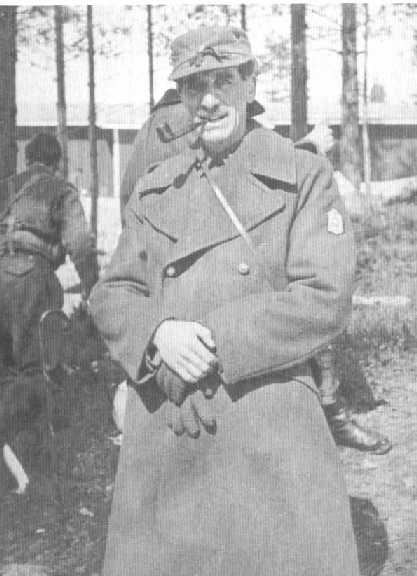
Captain Hugo Henry Chandor, Atholl Highlanders. Wingate appointed him to command of the Battalion Administration Platoon, which would remain at the Battalion’s Base Depot for the duration of the units time in Finland. It was a role he filled capably, although Wingate would at times abuse him mercilessly for perceived failures or slowness in carrying out instructions.
The Volunteers themselves were a mixed bunch. The most senior Officer of the Volunteers when Wingate stepped in was a Captain Hugo Henry Chandor, the intended supply and transport officer. Though he had fought in World War One, reaching the rank of Colonel and commanded a bombing school, as a leader Chandor appears to have been out of his depth – a “nice but very weak character”, as one early volunteer described him, and with “quite insufficient military experience or personality to train and organise volunteers”, in the estimation of another.
Wingate was not particularly impressed by Chandor, but he was also loathe to sack an experienced officer, and so appointed him to command of the Battalion Administration Platoon, which would remain at the Battalion’s Base Depot for the duration of the units time in Finland. It was a role he filled capably, although Wingate, who was certainly no respecter of rank or seniority, would at times abuse him mercilessly for perceived failures or slowness in carrying out instructions.
Chandor was an old Etonian who had been a Cadet in the Eton College Cadet Contingent. At some stage prior to 1921, he had been a sheep farmer in Argentina but had returned to the UK where he married Daphne Rachel Mulholland in 1921 (Daphne had divorced Esme Ivo Bligh, 9th Earl of Darnley in 1920). After Chandor married Daphne, he whisked her and her children from her first marriage away to live in a wooden house with an earth floor at Tres Barras, 600 miles into the interior of Brazil, where he built a sawmill.
After five years they returned to England, Daphne having been poisoned by drinking water from the well, which had dead toads in it. They went back to Chandor’s ancestral home at Worlingham Hall, Worlingham, Beccles, Suffolk. After serving with the Atholl Highlanders in the Winter War, Chandor would return to the UK and farm, also serving as an Officer in the Suffolk Home Guard, for which he received the OBE in 1944 when the Home Guard was finally stood down.
Major Peter Kemp – Rifle Company CO
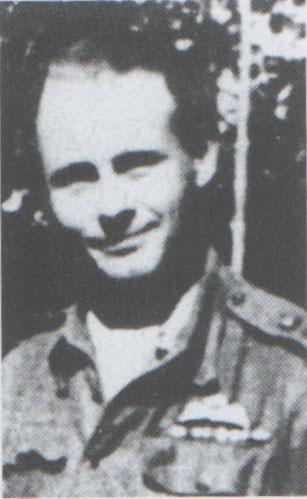
Peter Mant MacIntyre Kemp (born Bombay 19 August 1913 – died London 30 October 1993), known as Peter Kemp, was an English soldier and writer. The son of a judge in British India, Kemp was educated at Wellington School and proceeded to Trinity College, Cambridge where he studied classics and law. He became notable for his participation in the Spanish Civil War and during World War II as a member of the Special Operations Executive.
As a staunch Conservative and Monarchist, Kemp was alarmed by the rise of Communism and in November 1936, shortly after the end of the Siege of Alcazar, broke off from reading for the bar and travelled to Spain where he joined a Carlist unit under the Nationalists. He was given journalistic cover for entry into Spain by Collin Brooks, then editor of the Sunday Dispatch, “to collect news and transmit articles for the Sunday Dispatch from the Spanish Fronts of War.” He later transferred to the Spanish Legion where, in a rare distinction for a non-Spaniard, he commanded a platoon. Kemp was often badgered by his Spanish comrades about whether he was a freemason due to his protestant background. Wounded several times, he continued fighting until he suffered a shattered jaw and badly damaged hands in the summer of 1938 – the result of a mortar bomb, and was repatriated to England. He wrote about his time in Spain in his book, “Mine were of Trouble” (1957). His later book, “The Thorns of Memory,” also has several chapters on his experiences in Spain, although they read as if they were largely taken from the earlier book with a few revisions.
Seeking adventure but also as a result of his political convictions, Peter Kemp left the UK at the age of 20 to join Franco’s forces in November 1936. Compared to many international volunteers who met with some mistrust, Kemp was generally received with open arms. First, a member of the Carlist Requetes where, assisted by a few OTC certificates, he swiftly became a lieutenant; he then decided to switch to the tougher but rather more elite Spanish Foreign Legion as one of about three or four British officers. Thereon, he recounts a vivid tale of life in Franco’s forces, culminating in several battles and engagements, ultimately being wounded. The value of the book is in its non-leftist perspective.
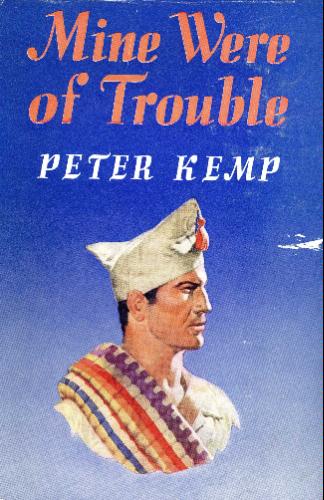
“Mine Were of Trouble” by Peter Kemp: A well-written account of an Englishman who decided to fight against the left in Spain’s civil war.
Kemp has many interesting things to say, particularly about the bombing of Guernica, which claims Kemp, since the Republicans had bombed Toledo in July 1936, was not the first large-scale bombing of a town, as well as the fact that the Republicans set fire to Guernica, as they had in Irun. He freely admits that the Nationalists were ridiculously naive in their propaganda compared to the more sophisticated and well-supported Republicans. Also an interesting point of view: the involvement of the International Brigades only prolonged a war that the Spaniards could have settled much more quickly and with much less bloodshed if left alone. Food for thought and a bit of a tonic to the usual fairy tale of how “the left were splendid fellows and everyone else was the devil incarnate”. At least we can salvage a bit of historical objectivity instead of being spoon-fed Hemingway, Orwell, Lee, Spender, Koestler, Malraux, Saint-Exupery, et al.
Having barely recovered from his jaw injury, Kemp volunteered for service with the Atholl Highlanders in Finland and was immediately accepted. Wingate spent two hours with him discussing his experiences fighting with the Spanish Foreign Legion in Spain and on the basis of their talk, accepted him and appointed him commander of a Rifle Company with the rank of Major. Kemp would lead his company well over the course of the Winter War, gaining a great deal more experience from working under Wingate and from Maavoimat training.
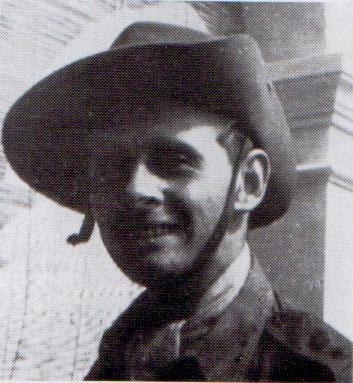
Peter Kemp with the Atholl Highlanders in Finland – late summer 1940. As part of the “image”, Wingate adopted the Australian bush hats his men wore from the men of the ANZAC and Australian Volunteer Battalions who fought with the Finns – Wingate was a master of publicity and he certainly knew how to create an “image” for his unit.
On his return from Finland after the end of the Winter War, Kemp had a chance meeting with Sir Douglas Dodds-Parker, the former head of MIR – which had been a small department of the War Office and a precursor to the Special Operations Executive (SOE). He was assigned as a pupil at the Combined Operations Training School and joined SOE. After further parachute and commando training he went on several cross-channel raids into Occupied France and was then posted to Albania, where he spent 10 months in clandestine operations in too close proximity to Enver Hoxha.
A mission in Poland resulted in capture by the Red Army and imprisonment by the NKVD. After three weeks in prison, he and Polish Home Army prisoners in the same jail were released by Maavoimat special forces as they and the resurgent Polish Army moved to recover control of Polish territory in the rear of the Red Army from the Soviets. Kemp relates in tones of distinct approval an account of how the Finns dealt rather summarily with the NKVD unit that had imprisoned him and had been interrogating and executing Polish Home Army prisoners. After a further two months in Poland working with the Poles and Finns, he was posted to Siam in the summer of 1945, where he ran guns to the French across the border in Laos. Tuberculosis forced his retirement from the Army once the war had ended.
Post-war Kemp sold insurance policies and turned to writing. As a correspondent for the Tablet he traveled to Hungary to report on the 1956 Hungarian Revolution and helped some students escape to Austria. He was present in the Belgian Congo during the troubles that led to independence as Zaire, and also covered revolutions in Central and South America as the foreign correspondent for The Spectator. His first book ‘Mine Were of Trouble’ described his experiences in the Spanish Civil War, ‘No Colours or Crest’ his wartime experiences in Albania and Poland as a Special Operations Executive agent, and Alms for Oblivion, his post-war experiences in Bali and Lombok. Before his death he produced an autobiography in 1990 called ‘The Forms of Memory’.
Malcolm Munthe – replacement Rifle Company 2IC
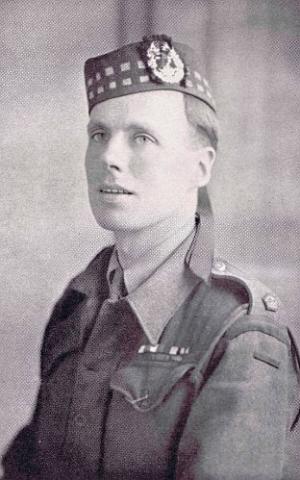
Malcolm Munthe (30 January 1910–24 November 1995) as an Officer in the Gordon Highlanders in 1939: He was sent to Finland with anti-tank munitions by the War Office as an advance party for the British volunteers, the Atholl Highlanders.
Another of Wingate’s officers was Malcolm Munthe. Born in 1910 and 29 years of age on the outbreak of WW2, Munthe was of Anglo-Swedish origins and had joined the British army as war broke out. He was assigned to the Gordon Highlanders for no other reason than his first name’s Scottish roots and was immediately commissioned as an Officer. Almost immediately after the Winter War broke out, he was recruited by the War Office for special operations in Scandinavia due to his Swedish background. . This was an irregular operation set up well before the establishment of the Special Operations Executive and Munthe was sent off to Finland to arrange the supply of munitions to the Finnish Army, carrying with him some experimental explosive devices. He was also to act as a one man advance party for the British volunteer unit, the Atholl Highlanders and he was almost certainly the first British soldier to make it to the Finnish fgront-lines, a story he recounts in his wartime autobiography, “Sweet is War.” In his own words…
“… I was to instruct some Finns under a lieutenant, whose name was Antila, in our anti-tank devices. We went west to Rovanjemi, and for some days to Kemijarvi, and then onwards by sledge. We were near a lake, beyond which were the Russian lines. I never saw a battle while I was there. Antila spoke no English, but we conversed to the best of our ability in Finnish-Swedish. His ski patrol was to be used for special raids to harass the enemy lines.
We slept fourteen in the tent, a circular contraption strung up on a central stovepipe, which carried away the smoke from the wood-burning stove in the middle of the floor. Christmas-tree branches covered the ground; they gave out a delicious smell when the place grew hot. We lay, feet to the middle and heads to the tent wall, with the equipment and rucksack of each man next to his head. I was put between Antila and his second in command, who was a sergeant. It was a tight fit. As I roll around in my sleep, I used to fling out an arm and hit one or other of them, but luckily Antila was just as bad. When we woke at reveille the appalling muddle would have to be straightened out.
Antila was sturdy, with thick dark hair and a permanent grin on his face. I imagine he was only a little older than I and it soon became obvious they had orders to coddle me. I was never allowed to accompany them on raids and was generally protected from even the mildest dangers. I spent my time making “clams” to blow up tanks. “808″ or “plastic” was the explosive used for these charges, with a block of guncotton to hold the detonator and fuse. The whole was then wrapped in a piece of mackintosh, proof against damp, and fitted with magnets so as to make it cling, clam-like, to the tank. The tent was redolent with a smell of almonds and geraniums emanating from the explosives, and I got rather bored with sitting cross-legged on my blankets and gradually covering it with neat little rows of these samples of my handicraft. When I protested, Antila patted my hair and asked with a superior air, “Want to die young?”
One freezing cold day after a particularly severe air raid out of an icy blue sky, I was sent back to Kemi, where a charming, spirited lady of the Swedish Red Cross drove me around in her lorry to some first-aid centres and field hospitals. She spoke excellent English. At one of the posts she introduced me to a Swede who was roaring down the telephone. “You must send them along to us more or less straightened out; otherwise, when they arrive here stiff, we have to spend hours limbering them up again before we can get them to fit into the coffins.”……
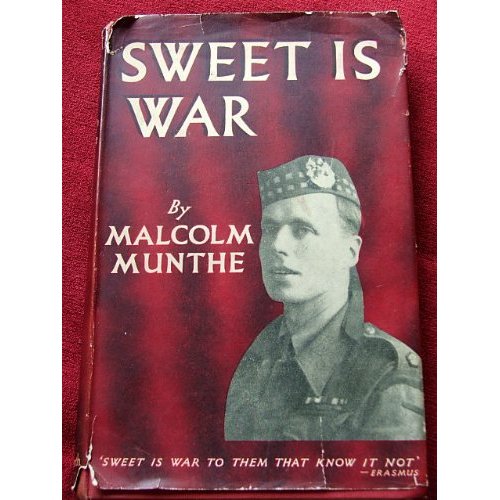
“Malcolm Munthe’s Sweet is War is a war memoir that reads like a novel. From a lovelorn London youth we follow Munthe through the banalities of boot camp to the British volunteer battalion sent to Finland to fight the Russians during the Winter War. Caught up in the fall of Norway, the wounded Munthe makes a heroic trek to the safety of neutral Sweden, preparation for his work as ‘Red Horse’, the ubiquitous director of resistance against the Nazis in Scandinavia. From the headquarters of covert operations in London, the young major moves out to North Africa to prepare the ground for the invasion of Sicily and the long hard struggle to liberate Italy. Malcolm Munthe knew well the casual brutality of war, its monstrous waste and random cruelty. He passed through ordeals which tested his sense of humanity to the full. Yet he retained his delight in the irony, comedy, beauty and heroic bravery to be found in this world.” This bitter-sweet memoir of the Second World War reads like a real life version of Evelyn Waugh’s Sword of Honour trilogy. Mr Munthe, who had been a page in the Swedish court as a boy was one of those few survivors of the way of life of pre-1914 Europe. His youthful war adventures are consistently farcical, yet take place amidst the horrors of war. The result is a gripping book, sure to appeal even to those who do not usually read war memoirs.
Munthe was a British soldier, writer, and curator, and son of the famous Swedish doctor and writer Axel Munthe (physician to the Swedish royal family and author of “The Story of San Michele”) and his second wife Hilda Pennington-Mellor (an English society lady whom Axel met and married early in the 1900s). Brought up between the Swedish court, Italy, and Britain, where his mother owned two large houses, “Hellens” in Herefordshire and “Southside House” in Wimbledon, Malcolm Munthe became a British citizen at the outbreak of World War II in order to fight, since he expected Sweden to be neutral throughout the war. In his youthful pre-war years, he studied for a Politics degree at the London School of Economics at the same time as he ran a boys’ club in a deprived quarter of Southwark, preparing himself for a career in the Conservative Party and taking part in the social round of debutante balls and London clubs. In 1939 he was offered the comparatively safe Tory seat of East Ham South, but the war intervened and he declined a political career to enter the military. He would end WW2 as a Major, winning the MC for bravery in the process.
Later recruited to the Special Operations Executive, he worked behind enemy lines in occupied Scandinavia – both in Norway and Sweden – as a spy and saboteur, famously blowing up a Nazi munitions train only miles from his own family home in Leksand, Dalarna. After a harrowing escape, recounted in his wartime memoir “Sweet is War”, he was put in charge of SOE’s activities in Southern Italy, where he participated in the Anzio landings. In Scandinavia, Major Munthe had established a network of “Friends” which he called the “Red Horse”, in imitation of the Baroness Orczy’s Scarlet Pimpernel. In Southern Italy, he took the mimicry further, dressing as a (large) old lady to smuggle a radio transmitter past Nazi lines and coordinate SOE activity in the occupied zone. Munthe was also instrumental in the rescue of liberal philosopher Benedetto Croce and his family, held captive in Sorrento, and their flight to Capri where his father Axel Munthe’s house Villa San Michele provided shelter.
After the war, Major Munthe continued to work in the military, and became active in social projects (described in his book The Bunty Boys). In 1945, he married the Right Hon. Ann Felicity Rea (born 15 January 1923), whom he met through her father Philip Russell Rea, 2nd Baron Rea, who was personal staff officer to Brigadier Colin Gubbins (the Head of SOE), and later leader of the Liberal party in the British House of Lords. After an abortive attempt at a political career with the Conservative Party, Munthe re-directed his work towards maintaining the family homes in England, Sweden and Italy. He sold his father’s remaining properties on Capri (the Villa Materita, inter alia), and bought the Castello di Lunghezza, a 108-room castle outside Rome. He opened Hildashol, the property Axel Munthe had built for his wife Hilda in northern Sweden, to the public, and did the same for Hellens and Southside House in England under the auspices of the Pennington-Mellor-Munthe Charity Trust, now (2007) chaired by his eldest son Adam John Munthe. Munthe dedicated his later years to running those properties, and writing, including a history of Hellens, Hellen’s, Much Marcle, Herefordshire and the Special Forces Club.He died at Southside House in November 1995.
Munthe had arrived in Finland in December 1939 and would fight with the Finns until March 1940, initially attached to a Finnish unit where he made magnetic anti-tank mines, he was soon attached to a Finnish Army training unit where soldiers were instructed in how to use the new British-supplied explosives. On the arrival of the Atholl Highlanders in Finland, Munth joined the unit where he was initially assigned to training the supernumeraries. After two weeks Wingate assigned him as a Rifle Company 2IC, replacing a casualty, after which he became a Rifle Company CO. After fighting with Wingate’s raiders on the Karelian Isthmus in spring 1940 and being wounded in action himself, he would be evacuated as far as Bergen in Norway where he would be caught up in the German invasion. He would escape from Norway to Sweden and eventually make it back to London, where he would go on to join SOE. After operating in North Africa and Italy, he would participate in the Anzio landing in early 1944, before being transferred back to Finland as SOE Liaison Officer for the Allies, attached to the Finnish Military Headquarters at Mikkeli where he would help coordinate assistance to the Polish Home Army.
Major Derek Tulloch – Battalion 2IC
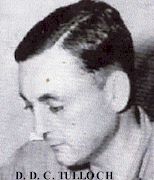
Donald Derek Cuthbertson TULLOCH (b. 28 April 1903, died 3 July 1974)
The only Officer that Wingate actually approached and asked to join the Atholl Highlanders was his old school friend, Captain Derek Tulloch. Tulloch had known Wingate from as long ago as their days at Charterhouse School, they had studied at Woolwich (the Royal Artillery School) over the period 1920-1922 together and had fox-hunted together for years. Tulloch was perhaps Wingate’s closest friend and when approached, he immediately agreed to Wingate’s request to become 2IC of the Battalion. War Office approval was immediately forthcoming. Promoted to Major on accepting the position, Tulloch led the first party on the journey to Finland. He would serve as 2IC under Wingate for the remainder of the Winter War and was on his return to the UK awarded the MC (Military Cross) and shortly afterwards (in 1941) promoted to Temporary Lieutenant Colonel. As with Wingate, fighting in Finland with the Maavoimat would give Tulloch many of the ideas and much early experience in operations behind enemy lines and in the logistical necessities inherent in such operations.
Donald Derek Cuthbertson TULLOCH (b. 28 April 1903, died 3 July 1974) was the son of Lieutenant Colonel D. F. Tulloch. He passed out from the RMA Woolwich Royal Artillery in 1923 and was promoted to Lieutenant in 1929, Captain in 1936 and Major in 1940. He was awarded the MC in 1940 and promoted to Temporary Lieutenant Colonel in 1941, Temporary Brigadier 1943 and served with the Chindits over1943 – 1944 (where he would serve as Chief-of-Staff under Wingate). He was awarded the DSO in 1944, promoted to Colonel in 1947, then Temporary Brigadier RA Brigade Southern Command in 1952. He served as ADC to HM the Queen and ended his military career as a Major General and C-in-C Singapore in 1954. He was awarded the CB in 1955. Before he died he wrote a somewhat hagiographical biography of Wingate, “Wingate in Peace and War” (1972).
CSM Charlie Riley – “A” Company – Company Sergeant Major
“A” Company CSM Charlie Riley was a New Zealander – actually a Cockney born in London’s Tower Hamlets in November 1893 who had first arrived in New Zealand in 1913. Although a keen student, Riley had to leave school at 15 to support his family and spent some tedious months in the counting-house of a tea merchant until “an army recruiting sergeant thought I would make a good soldier,” and offered him the traditional King’s shilling to enlist. The next five years were spent with the Royal Field Artillery at Woolwich Arsenal, until “the inside and outside of a fourteen pound gun, down to the last split pin, became as well known as one’s regimental number”. On his discharge at age 21 Riley resumed his childhood passion for ships and the sea. As an ordinary seaman he worked on a succession of tramp steamers, eventually carrying Italian emigrants to New York. Returning from one such voyage in April 1912, his ship encountered the floating wreckage of the Titanic. When “cold voyages across the Atlantic” lost their appeal, he signed on board the SS Tainui for Australia and New Zealand and was paid off in Wellington, New Zealand in April 1913. There he joined the passenger steamer Westralia, “a very happy ship” which shuttled across the Tasman and around the coasts of both countries.
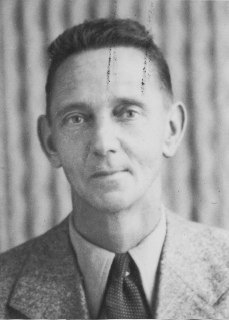
Charlie Riley circa 1938: Riley must have seen more battlefield experience than almost any other New Zealand soldier, was several times wounded and decorated, and was also a notoriously militant organiser of the unemployed during the 1930s.
His mother’s illness brought Riley back to the UK at the inauspicious time of July 1914. Upon the outbreak of war his ability to ride a horse saw him enlisted as a trooper in a heavy cavalry regiment, the Prince of Wales 3rd Dragoon Guards. After three months’ training at Canterbury in Kent, the regiment was sent to the first battle of Ypres where Riley would spend the next two years engaged in heavy fighting, eventually attaining the rank of Sergeant. “We had a gruelling time up there because in the winter time, 1914, 1915, [those years] were vile. We only had ordinary trenches about three feet deep and there was often two feet of water in them and we had ten days in and ten days out. ….. ‘We were in St Julian, that the soldiers called Sanctuary Wood, when the first lot of Canadians got the effect of the gas that the Germans had put over in shells. We were in reserve to the Canadians so we brought them out and… they were all as green as grass from the chlorine…. after a while the Germans gave up using gas. It didn’t work always because they quite often got it back.”
“In one attack we were unfortunate. We met up with a regiment of Prussian guards and they were all huge fellows… I remember going over the top, we met them about halfway and I saw one fellow coming at me so I was ready with the rifle and bayonet. I happened to slip just as I got in front of him. He took a lunge at me but he missed too so up I got quickly and into him, but before that his bayonet just nipped me in the arm, in the muscle.” After emergency dressing in the field, this wound became infected with tetanus and after some time in a hospital in France, Riley was invalided to Britain to make room for more urgent cases.
Discharged from the army as unfit, the resilient 23-year-old became a civilian gunner’s mate on an armed merchantman plying between Britain and South Africa. Towards the end of 1917 he sailed from Port Said to New Zealand on the SS Arawa, repatriating some 800 wounded New Zealand troops. There he was paid off, but “in view of the fact that I had a re-examination and my arm was all right, I had to rejoin and carry on. This time I enlisted in the Mounted Rifles. I went into Featherston Camp and I went off overseas with the 35th reinforcement and arrived in time for the final of the battles in Palestine.” After his final discharge in February 1919 Riley studied engineering at Canterbury University but failed to complete his qualification due to illness (perhaps a form of delayed shellshock). Instead he became a goldminer, and found work as a shot-firer in the West Coast Waiuta mine. By 1930 he was married and living in Christchurch but the onset of worldwide depression meant there was, “no work for a skilled gold miner with a licence to use explosives. My savings vanished within a year.”
Riley had by now become politically active on the left, first with the Labour and then the Communist Party. He became an organiser of the huge numbers of his fellow unemployed workers under the aegis of the Christchurch Unemployed Workers’ Movement. “We used to have our meetings outside in Victoria Square, Christchurch, and we built up a nice organisation… We had illegal demonstrations and so on, we fought the police, we had to. We had to take to the streets to make ourselves known. Oh, I’m well known down there (in Christchurch).” Over the next few years Riley took part in the 1932 tramways strike and accumulated 28 criminal convictions. Following the passage of the extraordinarily repressive Public Safety Conservation Act he was classed as a “rogue and a vagabond” and along with several other leaders of the unemployed, sentenced to a year’s prison. “After I’d been there ten and half months, they asked me if I would go out on probation. I said no, you’ve kept me here this long, I might as well see it out – I did.’”
In 1934, divorced and desperate for work, Riley made his way to Sydney, a city he knew from his seafaring days, and returned to gold-mining, first in Cobar, NSW and then Tennant’s Creek, NT, putting his expertise as a skilled miner and expert in explosives to use. In both mines he was lucky, his crew striking rich seams of ore and earning bonuses of 80 pounds a month each. “From poverty to affluence, it was a good feeling.” Isolated in remote mining camps, Riley spent his off-shift hours reading, thus learning of the rise of fascism in Europe, and especially of Hitler’s ruthless suppression of German trade unions along with Jews and other enemies on the left. The Australian miners and other unions raised funds for their support (“even poverty-stricken men gave their sixpences”), and sympathetic German seamen were secretly recruited to carry large sums to the underground resistance movements.
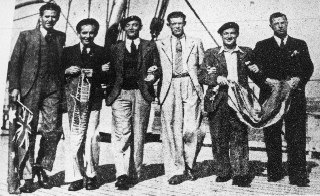
Riley (3rd from left) and Australian members of the International Brigades arriving home from the Spanish Civil War.
One day, lying on his camp-bed under canvas in the searing heat of Australia’s Northern Territory, Riley heard on his radio that on the far side of the world Franco and his fellow Spanish generals had launched a revolt against their country’s government and were being supported by the world’s fascist leaders. “That Hitler and Mussolini and the Spanish generals had begun attacking Loyalist Spain was about the last straw for us.” Within days he and a mate took the long and risky trek to Darwin, then returned by ship to Sydney, this time with “a small fortune in my pocket”. To save their funds, the two men signed on as firemen with a ship carrying wheat to Britain and after their discharge in Cardiff, the “two wild colonial boys took a first-class carriage to London”. There they made contact with recruiters for the International Brigades and as part of a group of over 100 volunteers, including a number of French Foreign Legion veterans, Riley made the grueling 14-hour trek across snowbound tracks through the Pyrenees, evading French machine-gun posts and searchlights. “Sometimes you had to run and drop down when the searchlights were in the vicinity, but anyhow, we made it and we arrived.”
In Catalonia Riley was enlisted in a mainly British unit of the XV International Brigades, and was soon thrown into action in the battle of Teruel. With characteristic offhandedness, Riley recalls the conditions as “pretty tough. The Germans and the Italians were far better off than we were. One thing we lacked was sufficient artillery and they had more aircraft than we did, although we were supplied from time to time with Russian bombers and they used to do a lot of good work.” Over the next 20 months Riley took part in the battle of Brunete, the later Republican offensive across the Ebro River and the subsequent disastrous withdrawal. In his 200-page memoir of the civil war (held in New Zealand’s Alexander Turnbull Library) he records his fascination at the differences he found between the idealistic Republican army and the British army in WWI. “There were no batmen or officer’s servants in the Republican Army; even the CO cleaned his own boots.” He is full of admiration for the women and children of republican Spain, and for regular Spanish troops such as the very youthful snipers. “Many of them were little taller than their rifles, but this did not prevent them from commanding respect.”
As a trained soldier with a knowledge of explosives and artillery, Riley gained the title of “shock brigader”, awarded to those with qualities of both military and political leadership. Already fluent in French, he acquired a useful knowledge of Spanish and trained the younger troops in the use of weapons and explosives. He also appears to have volunteered for some of the most dangerous actions of a very desperate war. “The night patrols were the more exciting of all night duties and … I must confess I used to enjoy taking part in patrol work near the lines. This was probably a stray heirloom inherited from the Great War period when in various sections of the Western Front, I seemed to enjoy (at the time anyway) creeping across No Man’s Land with other adventurous spirits loaded with hand grenades”. Riley’s memoir records in detail the various types of weapon, command systems and military tactics he observed, most of them new to him since the Spanish Civil War served as an important testing ground for the world war to come. “In the early fighting stages,” he subsequently recalled, “there was less than one rifle between each six defenders and many of the weapons were generations old. In the earlier days of the Rebellion, the antiquated Spanish Mauser held sway and there were many much more antiquated blunderbusses, carbines and flintlock pistols that did sterling work on the barricades, and which… might have found honoured resting places in any museum.” By the time Riley arrived in Spain, however, modern weaponry was arriving from the few foreign countries which officially supported the Republic, and he was issued with a Czech-made light machine gun with which to defend his column of infantry. “If planes came down, you took a potshot at them and got rid of them. They often flew low and you didn’t miss, you hit them somewhere and quite often a few were brought down.”
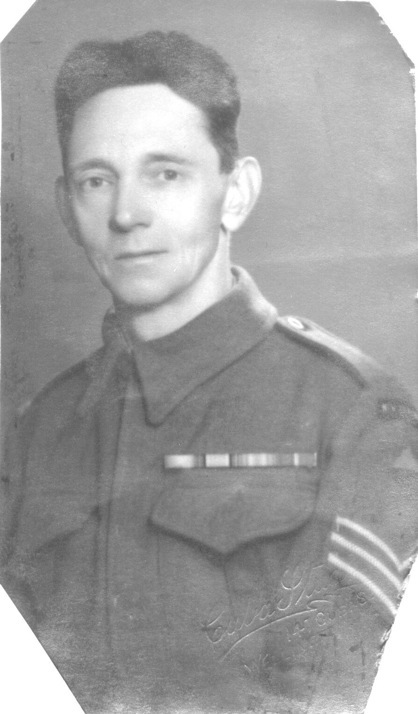
Sergeant Charlie Riley, New Zealand Army, April 1943
The Republican forces were generally less well equipped than their opponents and were often forced to improvise their weapons and strategies. Riley’s experience with explosives in the mines meant he was called upon to take part in the exceptionally dangerous work of close-quarter anti-tank warfare. “We carried about eight anti-tank bombs each. We used to get close to (the tanks) and throw them under the tracks and once they went off you’d see that the track had come off. They were immobilised then and all you had to do was find a place where you could throw another bomb in and kill the crew… If you get close to them they can’t shoot you, because their line of fire is beyond you.” No more than a dozen New Zealanders fought with the International Brigades, and Riley appears to have met only one other, a fellow seaman named Bert Bryan, from Timaru. The two met in combat on the River Ebro, the last major action of the International Brigades. “There was one place that was giving the Republican officers a headache and that was the Mora de Ebro bridge, so they sorted out half a dozen miners and I was among them and we mined the middle of the three spans.” Two nights later, the Republican fighters heard the rumbling of Italian tanks massed on the far side of the river. “The fuses were all ready and we just set them off. The bridge was half full of tanks when up she went and the three spans with it…. They never crossed the Ebro River, not while we were there.”
Soon after this success, however, Riley’s unit faced a fierce counter-attack from Italian infantry, and he was hit by machine gun bullets and shrapnel. “After being wounded in the head, face and left jugular artery, both shoulders and arms, I must have presented a pretty sight. One side of my face was a mass of congealed blood, the khaki beret which I held to my neck being saturated with the thick bloody mass… I still remember walking up a hillside to contact the dressing station which lay on the other side of the hill.” The still-conscious Riley was taken to Valls Hospital where his wounds became infected. “Only by long and careful treatment by the American staff and my Spanish nurses, Carmen and Tina, did I manage to retain my right arm.” That treatment included an emergency transfusion of blood donated by one of these nurses. Fortunately for the critically injured Riley, the quality of medical care available to Republican troops was generally very high. Volunteer doctors and nurses as well as combatants had arrived from around the world to support the Republicans, and together with native Spanish staff they pioneered battlefield medical techniques, such as the use of emergency blood transfusions, that would soon become routine. This treatment was provided under the worst imaginable wartime conditions and as Riley was transferred to a succession of hospitals, he witnessed a number of bombing raids on medical facilities. “Some time after I had left Valls, the hospital was bombed by insurgent air squadrons. Nevertheless it had remained untouched until almost the very end (of the war) for the reason that Franco had a country estate there.” At the time of this bombing, Riley notes, the hospital had a full complement of 400 patients.
After a month at Valls, with his right arm slowly recovering, Riley applied to rejoin his brigade but the hospital’s medical officer transferred him to the International Brigade’s Base Hospital at Mataro. There he met a number of Australian and New Zealand nurses, probably including Rene Shadbolt and Isobel Dodds who had been sent by New Zealand’s Spanish Medical Aid Committee. In late 1938, shortly before all International Brigaders were formally withdrawn from the front, he and other seriously wounded men were repatriated on board a Red Cross train to Paris. Still with his right arm in a sling, Riley arrived at London’s Victoria Station where he promptly weighed himself and noted the rigors of the past 20 months’ fighting. “The pointer registered at 8 st 7 lbs, which showed a loss of 2 st 7 lb.”
Riley was still in Britain when WW2 broke out and was preparing to return to New Zealand where he intended to rejoin the New Zealand Army. He, like many other left-wingers who were not out and out communists who toed the Soviet Party line regardless, was outraged by the Soviet attack on Finland. He had attempted to join the ANZAC Battalion in December 1939 but had been turned down as “unsuitable”, probably due to his political beliefs which would not have gone down well with the more conservative New Zealand volunteers in the UK, who came from rather more middle-class backgrounds. Undeterred and still in the UK in February 1940, he immediately applied to join the Atholl Highlanders at the age of 46 (while claiming to be 39). He somehow made it through the medical inspection and Wingate, on hearing of his experience in WW1 and the Spanish Civil War, immediately interviewed him. Wingate was somewhat of a maverick himself and he made no bones about caring not one whit for Riley’s leftist political convictions. Without further ado he appointed Riley Company Sergeant Major of “A” Company where he would be under the command of Peter Kemp. Oblivious to the politics of the Spanish Civil War, Wingate’s reason for putting him under Kemp was stated as “you chaps both fought in Spain, no doubt you have a lot in common….” Nevertheless, despite their political differences, both men got on well and Riley served capably under Kemp throughout the Winter War. Wounded in action in the fighting in Finland, Riley would recover and on his return to the UK, would enlist with the New Zealand Expeditionary Force in the Middle East.
Outside Tobruk he would be wounded a fourth time, once again surviving to be repatriated. As the narrator says in “Man Alone”, John Mulgan’s classic New Zealand novel, “there are some men you just can’t kill”. Back in New Zealand, the almost indestructible leftwing battler remarried, outlived his second wife and carried on alone in his Naenae state house until his death in 1982. Interviewing him in 1972 at the age of 80, Ray Grover recalls that “there was nothing military about him, but he had the attitude of a ranker, a chirpy little Cockney guy.” Unlike many of those who offered their lives to the Spanish cause only to see Franco impose decades of repression, Riley looked back on his actions without regret. “There was no bitterness in the man at all.”
Captain Allison Digby Tatham-Warter – “B” Company 2IC
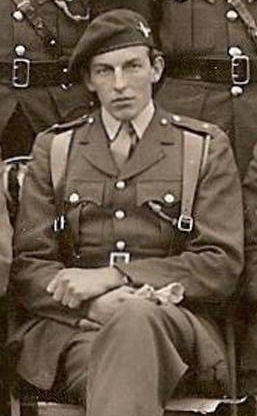
Major Allison Digby Tatham-Warter DSO (26 May 1917 – 21 March 1993)
Born on 26 May 1917, Captain Allison Digby Tatham-Warter attended Scaitcliffe school in Surrey with his brother John, where they became friends with Peter Wilkinson, who went on to have a distinguished career with the Special Operations Executive in the Second World War. He later attended Wrekin College and then the Royal Military Academy, Sandhurst where he became a talented horse-rider and won “The Saddle” as best horseman in his class. He joined the army in the late thirties and was commissioned as a second lieutenant on 28 January 1937. He was expected to join the Indian Army, but during an obligatory year-long attachment with a British regiment serving in India (in this instance the Oxfordshire and Buckinghamshire Light Infantry) he decided to remain with them and was officially transferred to the regiment in 1938. Whilst in India Tatham-Warter further demonstrated his horse-riding and hunting skills. During a pig sticking competition he once killed three wild boar that each averaged 150 pounds (68 kg) and stood 3 foot (0.91 m) tall. On another occasion he killed a tiger that was stalking the group he was with. He was still serving with the Ox and Bucks in India but was on leave in the UK when war was declared in 1939. Tatham-Warter was promoted to Lieutenant in January 1940 and after volunteering and being accepted into the Atholl Highlanders, he was made an acting Captain and appointed 2IC of “B” Company under Major “Mad Jack” Churchill.
His first experience of combat came in the Karelian Isthmus offensive of Spring 1940 where Wingate put “B” Company in the vanguard of the drop, believing that both Churchill and Tatham-Warter were “thrusters”. Tasked with seizing two key road junctions and a critically important bridge, the Atholl Highlanders were to seize these at dawn on the first day of the offensive. “B” company would advance straight from the glider landing zone to the bridge while the rest of the battalion took the two road junctions. The initial landings were largely unopposed and the various Companies formed up quickly. Tatham-Warter set up the Battalion rendevous using smoke and lamps, before the order to move off came just after 6am. B Company was in action almost at once; ambushing a small Red Army recce group near the drop zone before moving off through the woods toward the river road, with each platoon taking turns to lead. Tatham-Warter led the vanguard one mile from the dropzone to the bridge at a cost of only one killed and a small number of men wounded whilst having killed something like 150 Russians. He later remembered that “for me, the best moment of all was after our platoons had overrun the Russians guarding the bridge and I stood on the embankment to the bridge watching as they moved into position to cover the approaches from the north and the bridge itself.”
After the bridge had been taken, they were joined by supporting units from the Battalion, including four anti-tank guns and two 81mm mortar teams. Red Army units began counter-attacking almost immediately in an attempt to recapture the bridge and the fighting became heavier by the hour. During the fighting that followed, Tatham-Warter could often be seen calmly strolling about the defences, seemingly oblivious to the constant threat of mortar barrages and rifle fire. Choosing to wear his beret in place of a helmet and swinging his trademark umbrella as he went, Tatham-Warter, no matter how desperate the situation became, never failed in his ability to remain unconcerned and to encourage those around him. Even old hands had become somewhat disheartened at the sheer strength and size of the Red Army attacks but the gloom was lifted instantly at the sight of Tatham-Warter leading a bayonet charge against Russian infantry who had dared to enter Atholl Highlanders territory; carrying a pistol in one hand, madly swinging his umbrella about his head with the other, and now sporting a bowler hat on his head – which he had obtained from God knows where – doing his best to look like Charlie Chaplin. On another occasion later that same day he used the rolled up umbrella to in-effect disable a Russian armoured car, simply by thrusting it through an observation slit in the vehicle and incapacitating the driver, after which the rest of the crew were killed and the vehicle captured and used as a machinegun post. Tatham-Warter later revealed that he carried the umbrella because he could never remember the password, and it would be quite obvious to anyone that the bloody fool carrying the umbrella could only be an Englishman.
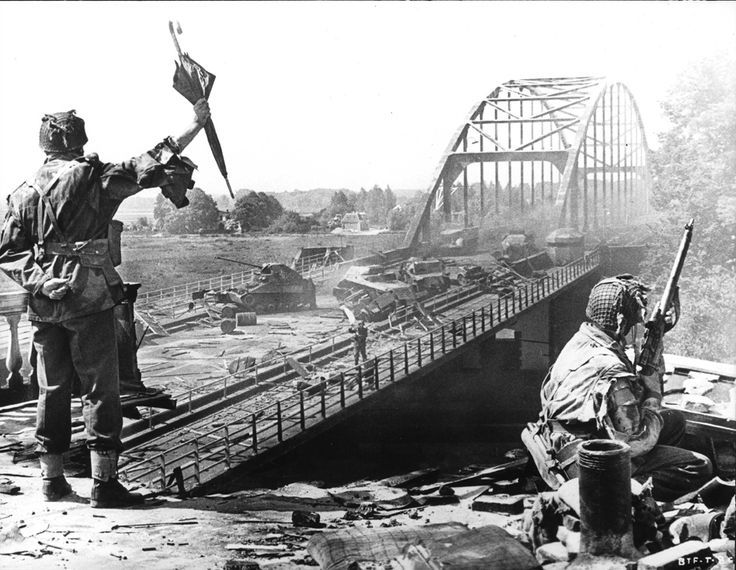
The Padre drew Tatham-Warter’s attention to all the mortars exploding everywhere, to which came the reply “Don’t worry, I’ve got an umbrella.”
During the battle, the Battalion Padre, was trying to cross the road to visit the wounded in a depression in the ground that provided at least a little cover. He made an attempt to move over but was forced to seek shelter from intense Russian mortar fire. He then noticed Digby Tatham-Warter casually approaching him. The Captain opened his old and battered umbrella and held it over the Padre’s head, beckoning him “Come on, Padre”. The Padre drew Tatham-Warter’s attention to all the mortars exploding everywhere, to which came the reply “Don’t worry, I’ve got an umbrella.” Shortly afterwards Lieutenant Patrick Dalzel-Job was sprinting over an open area he had been ordered to hold when he caught the sight of Tatham-Warter visiting men who were defending the sector, holding his opened umbrella over his head.
Dalzel-Job was so surprised he stopped dead in his tracks and suggested to the Captain “That thing won’t do you much good”, to which Tatham-Warter replied, after staring at him with exaggerated shock, “Oh my goodness Pat, what if it rains?” Rifleman George Lawson was running back to the Company HQ position for ammunition when he saw Tatham-Warter coolly walking around and directing men to fresh positions. Upon noticing Lawson he asked him what he wanted, and was enlightened, so the Captain advised him to “Hurry up and get some and get back to your post soldier, there are snipers about”, seemingly unconscious of the fact that he himself was a very obvious target. Such untroubled and good humored gestures doubtlessly contributed greatly to the morale of the defenders, and kept spirits high even when the fighting was at its fiercest.
Throughout the battle, Tatham-Warter was a model of leadership and continued to enliven spirits with his eccentric sense of humour, whilst also being tireless in making sure that the defences were as solid as they could be under the circumstances. The constant Close Air Support called in by the Finnish Army Fire Control Team attached to the Company also assisted the defenders considerably as the Red Army attacks grew increasingly desperate. Not having fought in a battle before and choosing an unusually violent one for his debut, Tatham-Warter asked of Major Churchill “I would like to know if this is worse or not so bad as the other things you’ve been in?” Churchill replied that it was hard to say as some things were worse, whereas some weren’t; they still had food and water, but were getting low on ammunition. The best thing, Churchill told him, was the air support – he’d never imagined it could be so effective. In constant touch with Battalion HQ by radio, they received the good news that evening that the Maavoimat’s 21st Armoured Division was advancing rapidly and had already reached the first road junction held by the Battalion and that Maavoimat Artillery was now within range.
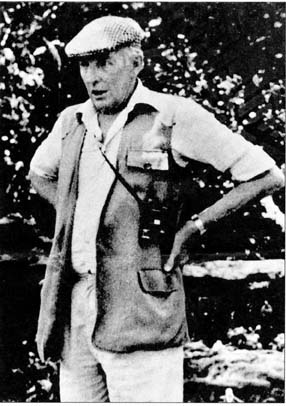
Digby Tatham-Warter in later years
This was just as well as the trapped Red Army units were increasingly desperate to escape from the one side, and to recapture the bride from the other. With artillery support now available, most of the night was spend hunkered down calling in artillery strike after artillery strike on waves of Red Army infantry. As dawn broke, the Red Army attacks reached a new frenzy, as did the calls for artillery and close air support. “B” Company held, albeit with many killed and seriously wounded and like the majority of the defenders, Tatham-Warter received several wounds, including minor shrapnel cuts to his posterior, which he shrugged off. Late that afternoon, the leading elements of the 21st Panssaridivisioona reached the bridge and immediately passed across, attacking the Red Army units on the other side of the river. “B” Company continued to guard the bridge for the next 2 days as Maavoimat units passed by in an endless stream. The Red Army front had been smashed apart and the road to Leningrad was open as long as the attackers momentum was maintained.
Tatham-Warter would recover from his minor wounds and, like the rest of the Atholl Highlanders, go on to fight in a series of raids behind the Red Army lines before returning to the UK. He would return to Finland in late 1943 as a Major commanding a Company of the British Army’s 1st Airborne Division where he would participate in the airborne landings that heralded the start of the invasion of Estonia. His last major action would be the drop of the 1st Airborne Division, the Maavoimat Parajaeger Division and the Polish 1st Independent Parachute Brigade into Warsaw to fight alongside the Polish Home Army in the Warsaw Rising. Once again, he would be there to welcome the Maavoimat’s 21st Panssaridivisioona as they broke through the German defences to relieve Warsaw. He is recalled as a particularly severe but inspirational commander of his men (few of whose names he apparently knew, nor was particularly interested in). The soldiers were there to follow and to fight and he, above all, to lead. His officers (mainly drawn from similar backgrounds as his) were expected to emulate his attitudes and standards. Derek Tulloch, Tatham-Warter’s Battalion 2IC in Finland, once remarked (probably in Digby’s defence): “But every battalion needs a Digby!” Officers, and many of the men, who served with and under him would almost certainly agree
OTL, Major Tatham-Warter volunteered for the Parachute Regiment in 1943 and in September 1944 he accompanied the 1st Airborne Division to Arnhem during Operation Market Garden. In the ensuing battle he was part of the small force that actually reached Arnhem road bridge and defended the northern end for several days before being overrun. Although captured by German forces he quickly escaped and contacted the local resistance. Over the next month he organised dozens of survivors from the battle who were in hiding behind enemy lines, before leading them to freedom south of the Lower Rhine. For his part in the battle and escape operation he was awarded the Distinguished Service Order. After the war he moved to Kenya where he became a hunter and in a somewhat eccentric manner ran a safari park, becoming a pioneer of camera-shoots. He died in 1993 at the age of 75.
RNVR Sub-Lieutenant Patrick Dalzel-Job, Platoon Commander, “B” Company
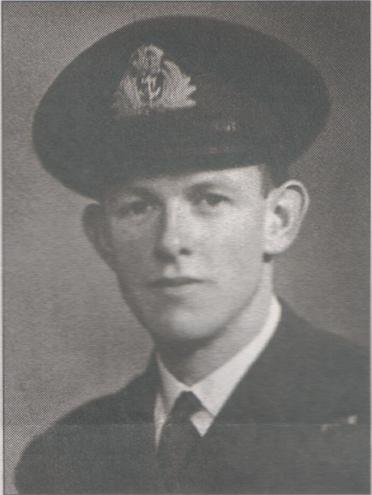
Patrick Dalzel-Job as a young and recently-commissioned Naval Officer
Patrick Dalzel-Job was born near London in, the only son of Captain Ernest Dalzel-Job, who was killed in the Battle of the Somme in 1916. He suffered ill health as a child and his widowed mother took him from Hastings to Switzerland, to regain his strength. Here, Patrick became accomplished at cross country skiing and then ski jumping and taught himself to sail on a lake near the French border whilst studying navigation by correspondence course. He returned to Britain in 1931, built his own schooner, the Mary Fortune, and spent the next two years sailing around the British coast with his mother as his crew. In 1937, they crossed the North Sea to Norway and spent the next two years making studies of the west coast and the fjords, channels and islands and sailing as far north and east as Petsamo, in Finland. He and his mother were accompanied by a blue-eyed little Norwegian schoolgirl named Bjørg Bangsund. The Norwegians were most hospitable and Patrick soon became fluent in their language.
In late August 1939, a radio broadcast persuaded Patrick and his mother that war was imminent and they returned to England. Patrick was commissioned into the Royal Navy on 8 December 1939, and requested a posting as far north as possible. He was appointed navigating officer on a target towing tug working from Scapa Flow in Orkney from January 1940.
Ever eager to return to Norway and the north, Dalzel-Job applied in writing to join the Atholl Highlanders on reading of the need for Volunteers for Finland in the newspapers. His application had been discarded (a naval officer, after all) when Wingate happened to come across it as he was looking for a scrap of paper on which to jot some notes – almost at the last moment as it was on the last day before Wingate was to leave for Norway. That evening, Dalzel-Job received a telegram ordering him to Glasgow where he was to report on board the cruiser HMS Southampton. There he was to join Lt-Col. Wingate and the last contingent of the Atholl Highlanders, who were to travel to Finland via the northern Norwegian port of Lyngenfjiord. He made it with only a couple of hours to spare and on 12 March they sailed together with 4 cargo ships carrying war materials and a small escort of destroyers.
It soon became evident that Dalzel-Job’s knowledge of the area and weather conditions was invaluable as the naval ships had no detailed maps of the area where they were to be transported to. In addition, on arrival at Lyngenfjord it was found that the limited docking space available was tied up with cargo ships unloading military supplies around the clock and there was simply nowhere to unload the troops. Wingate asked Dalzel-Job’s advice, and immediately accepted his suggestion that the soldiers could land from the cruiser using the local fishing boats (skøyter, which Dalzel-Job referred to as ‘puffers’). With his colloquial command of Norwegian, Dalzel-Job soon had the local fishermen organized and the men were taken ashore in these boats on 14 and 15 March 1940. He was later to say “I called them puffers because as a child in the West Highlands, all our goods used to come up from Glasgow in little round ships called puffers. They were built like that to come through the Grand Canal and the Norwegian word for these boats was skøyter. Well, of course, no British people would say skøyter so I called them puffers and Wingate thought that was the Norwegian name and official reports said “local boats called puffers” – but they were called puffers only by me.”
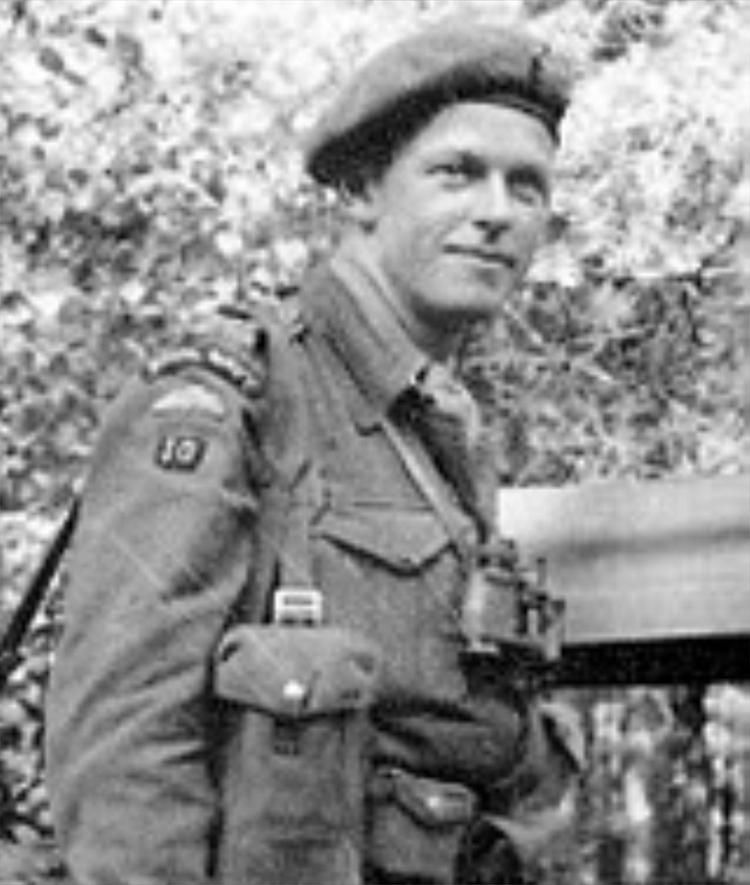
Sub-Lieutenant Dalzel-Job with the Atholl Highlanders, Finland, 1940. “By the end of summer, 1940, I had commanded a Platoon in the glider landings on the Karelian Isthmus in the Spring, and then been on four deep penetration missions behind the Red Army’s lines attacking rear area units and supply dumps. I had jumped out of an aircraft using a parachute twice, been in so many firefights I had lost count and half my men had been killed or wounded in action. I had fought alongside the Finnish soldiers of Osasto Nyrkki and for the rest of the war, whenever things got rather challenging, I would say to myself, “What would Osasto Nyrkki do here” and the answer was usually the most outrageously aggressive and daring solution you could think of. So that’s what I would do.
With his knowledge of Norwegian, Dalzel-Job proved an invaluable aide to Wingate in getting the men and equipment off loaded and organized on-shore. His knowledge and experience of the climate and conditions also led Dalzel-Job to rapidly organize with the Norwegians and later with the Finns for the provision of more suitable clothing and equipment for the British volunteers even prior to their moving out on a large convoy of overloaded Finnish trucks. A week later the Atholl Highlanders were in Lapua and being put through Finnish Army training, which Dalzel-Job found an enjoyable challenge. “It was tough, far tougher than I had ever imagined such training would be or could be, but we all learnt a tremendous amount in the shortest imaginable time. There was not a moment wasted and our Maavoimat instructors, many of them recovering from wounds received in the early fighting back in December, kept drumming it in to us that we had to learn fast and that a single mistake in fighting the Russians would get us killed.”
When the Atholl Highlanders moved up to the Karelian Isthmus on the reserve lines, Dalzel-Job was in command of a Platoon within “B” Company under Major Churchill. The Battalion continued to train hard as they manned the rear defence lines and listened to the guns. “The artillery went on day and night and when it crescendoed, we knew the Russians were up to something and we were all on edge a bit. But the Finns were good at keeping us informed as to what was going on and they never showed any doubt as to the outcome. The common refrain was “The Marski knows what he’s doing” and they had an unshakable faith in him, which of course as we all know now was entirely correct. We ended up meeting “The Marski” – even we ended up referring to Marshall Mannerheim by that term – when we left Finland in late 1940 after the peace agreement with the Soviet Union was signed and he turned up for our last parade before we were trucked north to Petsamo (by that time Lyngenfjiord was a bit close to the Germans for us to ship out from). He was certainly an imposing figure with a real presence that you could feel and he spoke excellent English.
Then, I have no idea how it happened but Lt-Col. Wingate somehow got us attached to the Maavoimat’s Parajaeger Division and we trained with them for a couple of weeks and then took part in the big offensive that the Finns launched to retake the Karelian Isthmus from the Russians in Spring 1940. We were carried in Gliders, we’d never heard of using gliders to carry soldiers into an attack before but the Finnish soldiers were all very blasé about it so we just did our training and then when the time for the Op came, we gritted our teeth and climbed in and hung on. The whole attack seemed to take the Russians completely by surprise and the Maavoimat just took them apart chewed them up and spat out the pieces.
Now, I can say that it was “Blitzkrieg” before the Germans showed how it was done to the rest of the world in France in May 1940, but this was a month earlier and the Finns certainly didn’t publicise how they did it but from our part in it, we had a pretty good idea. Of course, when we got back to the UK we had to write up all sorts of reports on what we’d seen but as far as I could tell, they all just disappeared into the usual Intelligence black hole and nothing ever came of them – the British Army certainly didn’t learn a thing although in the Commandos and later in 30 AU we put the Finnish tactics we’d learnt to good use. So did Wingate and Tulloch and Mike Calvert for that matter with the Chindits in Burma, and of course everyone knows about David Stirling and the SAS – and all of that had its origins in the 2 British units sent to Finland and the experience we gained there.
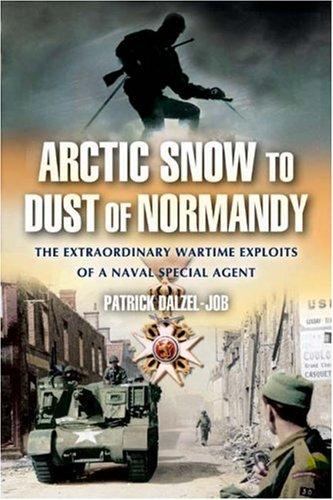
Patrick Dalzel-Job released his memoirs, titled From Arctic Snow to Dust of Normandy in 1991 and died on 14 October 2003, aged 90 years.
After the Spring Offensive, we got pulled out to recover and then we did some more training, this time with the Maavoimat’s Osasto Nyrkki special forces unit – they were the real elite of the Finnish Army and they pulled off all sorts of amazing feats – blowing up the NKVD Headquarters in Leningrad was just one of them – they also took out a whole Russian airfield with hundreds of aircraft – I think that was where Stirling got some of his ideas from, from that raid. Anyhow, we trained with them and then we did a whole series of missions behind the Red Army lines where we were attacking headquarters units and logistical supply dumps and railways and bridges and things deep inside the Soviet Union. We would be flown in and either parachute in or land in floatplanes – the Finnish Air Force, the Ilmavoimat, had a lot of those, and then we would do our mission and usually end up running away from the Russians who would chase us through the forests and swamps, and then we would be picked up or we would exfiltrate through the Red Army lines back to the Finnish side, take a break and then do it again.
Depending on the mission, we could be anything from a small team up to a whole Company and once even the entire Battalion. I found the whole thing rather exhilarating at the time and even though it was dangerous, I never worried about that aspect of what we were doing. No doubt it was the boundless self-confidence of youth. I did feel sorry for the Russian soldiers at times, it was like killing baby chicks a lot of the time but it had to be done. The NKVD rear area troops were different though, they were quite often fairly good and you didn’t want to fall into their . hands either – we had seen the results of that once or twice and after that, we never passed up the chance to take them out. And the Finns had an evil way with booby traps and devices to slow them down when they were chasing us, we put that to good use many times. The Finns were great chaps to fight alongside, not great talkers and their sense of humor was a bit challenging at times but they knew their way round the woods, their fieldcraft was really good and they were superb soldiers. Not much discipline compared to us, and we were no great shakes compared to the regular British Army – in fact the way that we and the 5th Bat Scots Guards operated ended up becoming the modus operandi for units like the Commandos and the SAS later on and that was all picked up from working with the Finns and with Osasto Nyrkki in particular.
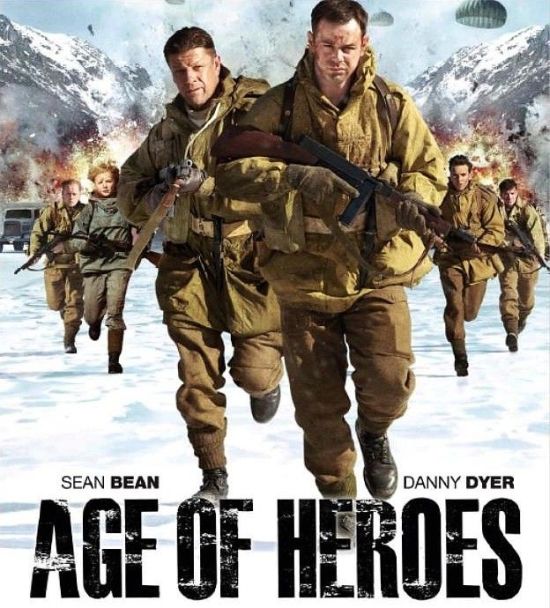
“Age of Heroes” – the 2010 movie about Ian Fleming’s 30 Assault Unit.
After his return to the UK from Finland in late 1940, Dalzell-Job would return to the Navy and spend almost two years on ships before going on to become a Commando and a distinguished Naval Intelligence Officer. In June 1942, Dalzel-Job was assigned to collate information about the west coast of Norway. A few months later, Lord Louis Mountbatten, head of Combined Operations, chose him to convey Commando raids there, known as ‘VP operations’, using eight ‘D’-Class Motor Torpedo Boats. From mid-1943 until early 1944, he served with the 12 (Special Service) Submarine Flotilla becoming versed with X-Craft and midget submarines, while taking time to complete parachute training with the Airborne Division. As prospects for major action in Norway faded, Dalzel-Job visited London and discovered 30 AU (Assault Unit) Commando, the field operative unit of the Naval Intelligence Division – Room 30. He transferred to 30 AU under the command of Commander Ian Fleming who was then Personal Assistant to the Director of Naval Intelligence.
In this role, and promoted to Lieutenant Commander, he landed near Varreville on Utah beach, Normandy, on D+4 with two Royal Marines Commandos allocated to him, and an unrestricted authority order signed by U.S. General Dwight D. Eisenhower to pass through Allied lines and assault specific targets in German held territory. In June 1945 he returned to Norway and found the blue-eyed young Norwegian girl (Bjørg Bangsund, now 19) he and his mother had sailed with before the war. They were married in Oslo three weeks later.OTL, Dalzel-Job served with the Anglo/Polish/French Expeditionary Force to Norway from April to June 1940, during which time he disobeyed a direct order to cease civilian evacuation from Narvik. His action saved some 5000 Norwegians for which King Haakon of Norway awarded him the Ridderkors (Knight’s Cross) of St. Olav in 1943. This award saved him from being court-martialed. Brave, reckless and a maverick known for his disregard for authority, Patrick Dalzel-Job was the nearest real life model for James Bond and the release of his war records, protected by the Official Secrets Act for more than half a century, appears to strengthen his position as the “true” 007.
Dalzel-Job ended up working for British Naval Intelligence and was recruited by Ian Fleming to join his undercover 30 Assault Unit, a special force which would race ahead of Allied front-line troops to seize secret German equipment and documents before they could be destroyed. Like Bond, he piloted miniature submarines and could ski backwards. Just as Bond’s independent attitude frustrates ‘M’, so the lone wolf Dalzel-Job had no qualms about disobeying orders. Confidential reports by senior officers show parallels with Bond. “He keeps himself in an exceptionally high state of physical fitness, he can withstand an unusual amount of hardship and exposure,” said one. Another report stated: “An unusual officer who possesses no fear of danger and has been used to living on his own. When the work appeals to him he is a first class officer.”
Second Lieutenant David Vere Stead, Platoon Commander, “B” Company
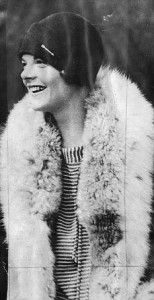
Nell Vere Stead, sister of David Vere Stead
Another of the “B” Company platoon commanders was Second Lieutenant David Vere Stead. Stead was an Australian from Melbourne, the son of Australian millionaire David Sydney Vere Stead and the brother of the first Australian woman to become a duchess – the former Melbourne socialite, Nell Vere Stead, whose husband, a Navy Commander whose full name was Alexander George Francis Drogo Montagu (known by the courtesy title of Viscount Mandeville but always known as “Mandy”) and who was to become the 10th Duke of Manchester in 1947. Grey Duberly, daughter of local landowners Hugh and Saffron Duberly, recalls that it was at her parents’ house, Staughton Manor, that Nell proved most adventurous. ‘One exciting night, she came to dinner. She had on a dress made of mink or something. After dinner, she dumped it and stepped out – completely naked.’
Lieutenant Karl Nurk, “HQ” Company, British Army Liaison Officer to the Finns
Lieutenant Karl Nurk was an Estonian, born in Tartu on 24 June 1904, died in South Africa 28 July 1976. He was the son of Karel August Nurk, a pawnshop owner, and Ernestine Josephine Vastrik and had two brothers, Helmi Nurk and Richard Nurk.
As a 13 year old volunteer, he had been one of the youngest soldiers in the Estonian War of Independence. After Estonia had secured its independence, he had taken part in the fighting against the Russians in Eastern Karelia as a volunteer. He then attended the H. Treffneri Gümnaasium (in Tartu, Eesti) from which he graduated in 1923. He then served in the Estonian War Ministry but in 1924, he decided to embark on adventurous journey into the wider world beyond Estonia. He travelled to France, where he met a fellow Estonian, Evald Marks, who had an unusual plan – to “walk” across the Sahara desert. The Estonian Ministry of Foreign Affairs website mentions that in 1925, two young men from Tartu, Evald Marks and Karl Nurk, spent some time in Tunisia and that in November of the same year they set off from the city of Gafsa on their 7 month hike through the Sahara Desert. They apparently started out with camels but ended the journey on foot after their camels died (there were also rumors that the two had deserted from the French Foreign Legion but this seems to be fictional rather than factual).
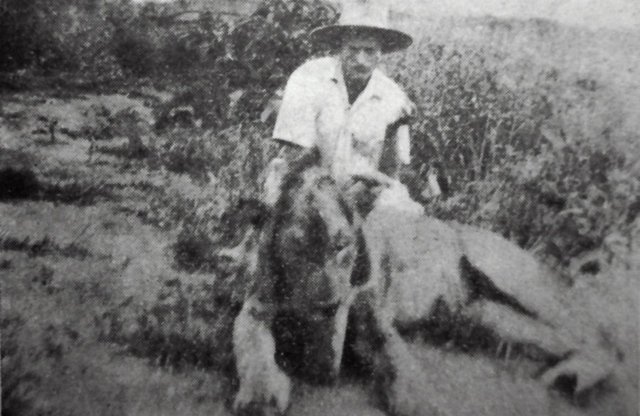
Karl Nurk, an estonian who would go on to become a Colonel in the British Army, with a lion he hunted and shot in Tanganyika
After their successful desert crossing, they spent some time in the French corner of Central Africa as professional elephant hunters (hunting for ivory was fairly lucrative in the inter-war years if you were up to the challenge of successfully shooting enough elephants to make it worthwhile). Later the two continued on to British East Africa, they are recorded in 1928 as having been Estate Managers for the Earl of Lovelace in the area around Babati, Kenya, where the Earl owned coffee estates. In 1934 Nurk once again began to hunt elephants in Tanganyika. At some stage it appears he married an Englishwoman who owned a sizable plantation and thus became somewhat wealthy himself. Back in the UK at the outbreak of WW2, when the Winter War broke out, Karl Nurk visited the Finnish Embassy in London and expressed the wish to go for help in the fight of the Finns against the Russians. The Finnish Embassy referred him to the British Volunteer unit being set up, where Nurk successfully presented himself as a military veteran with experience fighting in Karelia as well as a successful citizen of British East Africa.
Nurk was promptly signed up and commissioned as a Lieutenant. After interviewing him, Wingate attached him to HQ Company, explaining that there were few enough Finnish speakers in the British Army that he would be invaluable as an assistant to Wingate. They also apparently spend considerable time talking about their respective Saharan desert trips, a common interest which gave Wingate a high regard for Nurk. They would work well together throughout the Winter War, with Nurk acting as an Aide to Wingate through to the end of the campaign. Indeed, such was the regard that Wingate held Nurk in that he would take Nurk with him to Ethiopia ater Italy had declared war on Britain and Wingate was sent to Ethiopia, where he would form “Gideon Force” to fight the Italians. Second Lieutenant Nurk would serve with the 2nd East African Irregulars, training Ethiopian Irregular units. In November 1941 he was involved in the conquest of Gondar. In a book published after the war in the UK (1949) about the fighting in Abyssinia, Nurk was repeatedly mentioned by name – at the time, on 21 October 1941 (ref London Gazette) he was promoted to Captain (General List) and awarded the Military Cross.
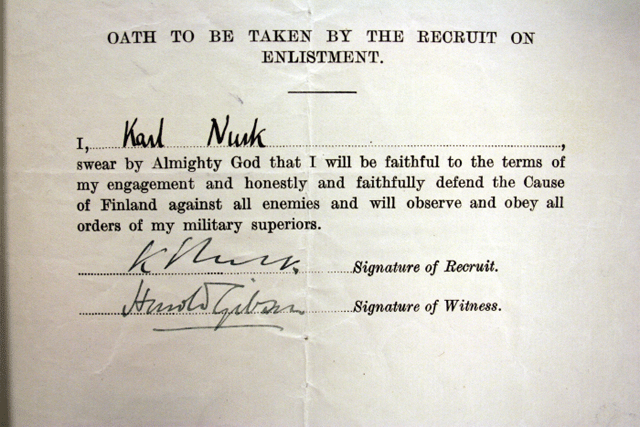
British Volunteers for Finland – Oath – signed by Karl Nurk and Harold Gibson
After completion of his assignment Abyssinia he was posted to Iran and then in 1942 to Cairo, where he was on the General Staff. In 1944 he was part of the SAS unit sent to Yugoslavia and based on Visi Island, from where they supplied and supported Tito’s forces and carried out raids against the Germans, actions in which Nurk often took part. In one such attack against the Germans Nurk was wounded by a grenade after which he was sent to a hospital in Italy and then to Algeria to recover. In August 1944 he was dropped into southern France behind the front as part of a SAS unit. His unit was in contact with the French resistance movement, and carried out a series of attacks behind the German lines. Roy Farran mentions Nurk a number of times in his recollection of his time in the SAS during WW2, however he is referred to in Phillip Warner’s “The SAS” as a White Russian.
On 13 June 1944 Nurk is mentioned in the London Gazette has having been awarded the DSO and somewhere in this timeframe he was promoted to Major. In 1947, shortly after WW2, Nurk became a British Citizen (Naturalisation Certificate: Karl Nurk. From Russia. Certificate AZ28546 issued 21 June 1947) and in 1949 he was awarded the Military Medal of Haile Selassie 1st Class. From 1949 to 1953 he was part of the British Military Mission in Greece. From 1954 to 1957 military attaché at the British Embassy in Ethiopia he was the British Military Attaché at the British Embassy in Ethiopia, at which time he is recorded as holding the rank of Colonel. After retiring from the military, he lived for some time in the UK, where he had an acting role in the 1965 movie, “The Naked Brigade” playing the role of Professor Forsythe. In 1966 he moved to South Africa where he lived for the last 10 years of his life. Having survived countless adventures, Karl Nurk died on 28 July 1976. He was survived by his wife, Madeleine, and son. His death was reported in the “Voice of Africa” 1976 22 Oct Nr. 1503, p1-2 and in the Free Estonian, Toronto, Canada.
OTL Note: Nurk was a Platoon Commander with the British Volunteers in Finland. He managed to escape through Petsamo by ship to New York, after which he returned to the UK and was commissioned as a Second Lieutenant on October 1940 (ref the London Gazette). The service with Wingate in the Winter War is ATL, all else in this brief biography is factual.
Lieutenant Duncan Dunbar Guthrie, Platoon Commander, “D” Company
Duncan Dunbar Guthrie was born in London on 1 October 1911. Prior to WW2 he had been an actor, a journalist and a playwright. His most notable acting appearance was in the 1935 film, “Riders to the Sea” – a photo of the cast appears below (without names unfortunately). He also acted in a further film, “Children of the Fog.” Whilst his beliefs were socialist, Guthrie volunteered to fight in the Winter War and was signed on as a Lieutenant. He would lead a platoon within “D” Company for the duration of the Winter War. After the return of the British Volunteers to the UK in late 1940, Guthrie would join the Royal Canadian Artillery, then transfer to the Duke of Cornwall’s Light Infantry in 1943. He at some stage shortly after this transferred to SOE and as a Captain, led Jedburgh Team Harry, dropping from Tempsford to Central France on the night of 6-7 June 1944. After the war in Europe ended, he was promoted to Major and transferred to SOE in South East Asia and was dropped into Burma to join the Karen guerillas fighting behind the Japanese lines. He broke his leg on landing which effectively ended his participation in the War.
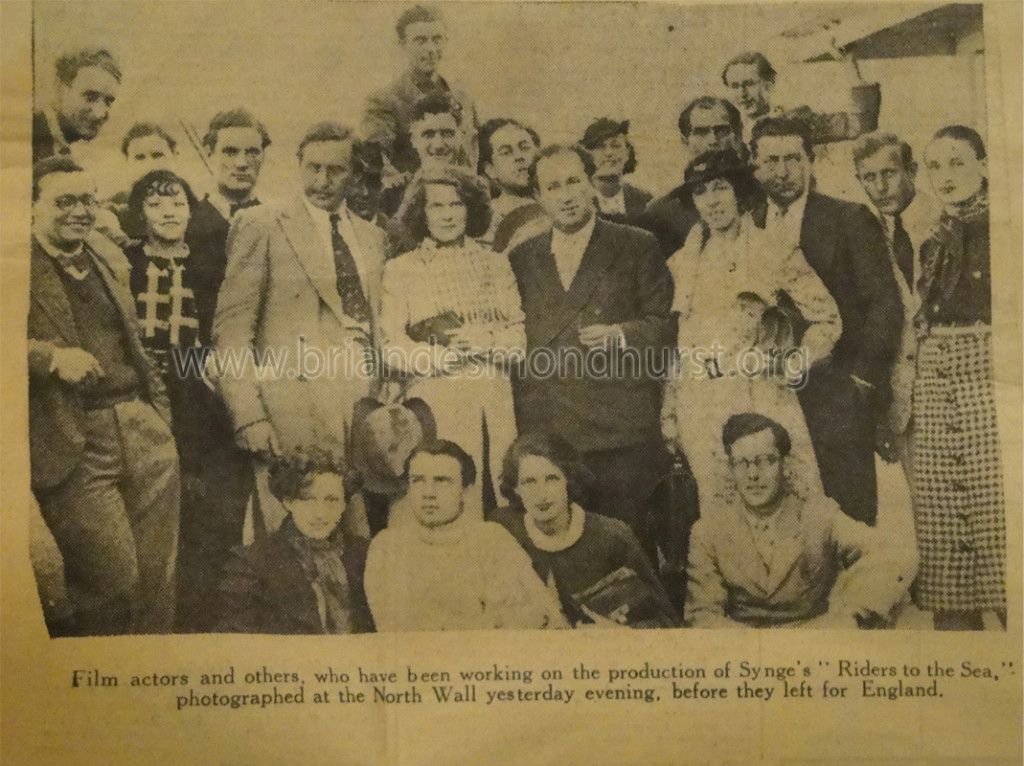
Actors from “Riders to the Sea” – photo from 1935 at the end of filming. Duncan Guthrie is among these but none are named
Shortly after WW2, he became involved in the financial support of medical research. This started in 1949 when Janet, his first child, developed poliomyelitis (Guthrie married Prue Holloway in 1949). This was at a time when progress was being made in the United States in the development of poliomyelitis vaccines, while in Britain, as the late Bill Bradley of the Department of Health said, “The problem of polio in England is – ignorance, impotence and insecurity.” Guthrie alerted society to this problem at the Festival of Britain and with his wife Prue set up the National Fund for Poliomyelitis Research with himself as the Director. Their first headquarters was two tiny dark rooms up three flights of stairs above a fruit shop in Spenser Street, in Westminster. Guthrie deplored the development of palatial offices and large staffs by charities and insisted that money collected for a charity should be spent on its aims. When Director of the NFPR, he had to be persuaded to accept an increase in salary for himself while his wife was doing a full-time job to help support the family of three children.
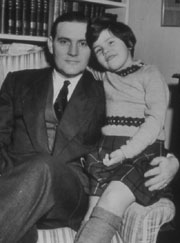
Duncan Guthrie with his daughter Janet
In fund-raising, Guthrie demonstrated the same fertile and imaginative mind that had engineered his escape from Norway during the Second World War when the British Volunteers for Finland, to which he belonged, was disbanded; and that he had shown in France when he was dropped there by parachute to fight with with the Maquis and liberation forces, and later when he hid for weeks in the Burma jungle with a badly broken foot following another parachute jump. One of Guthrie’s earliest innovative fund-raising efforts was to introduce the popular Christmas Seals – adhesive seal stamps – by having a real seal (which refused to go in the lift) flobber up the stairs at the Waldorf Hotel. (He was discouraged from inviting the Lord Privy Seal to the reception.) In the organisation of the NFPR, which became known to many as the ‘National Fund’ or the ‘Fund’, he was subtle in using the power and the influence of the grandees on the Council but at the same time he had an advisory body of carefully selected experts who advised on the distribution of the funds which were collected. In the early days the fund supported the first European trials of oral poliovirus vaccines in Belfast which established their effectiveness and safety standards for their subsequent world use.
Following this, the fund supported many other aspects of medical research in relation to problems of disablement and funded the endowment of 13 medical chairs in universities in the United Kingdom. Guthrie was given an honorary doctorate and masters degrees from several universities, but he sought no recognition for the greatest contribution any individual has made to funding medical research in the United Kingdom. After polio could be beaten, he changed the name of the fund to Action Research for the Crippled Child, which continued to support a wide programme of research in disabling diseases. Guthrie then turned his attention to the relief and rehabilitation of the paralysed, not only in the UK but in the developing world, and set up ‘intermediate technology techniques’ for developing equipment for the locomotion of the disabled in developing countries. When he retired as Director of Action Research he initiated a programme at the Institute of Child Health to provide essential health education for rural populations in Third World countries, particularly in Africa. This was called ‘Child to Child’ and was largely based on the novel idea of older children teaching their siblings about disease prevention and other health problems. With Alf Morris, he was closely involved in the All Party Chronically Sick and Disabled Persons Act (1970), which paved the way for subsequent legislation for the disabled in the UK. He was awarded the OBE in 1976.
Guthrie died at Amberley, West Sussex on 12 October 1994. He was survived by his wife, one son and two daughters. He was the driving force behind introducing polio vaccinations into the UK.
Lieutenant Sir Graeme Duncan Power Sinclair-Lockhart, Platoon Commander, “D” Company
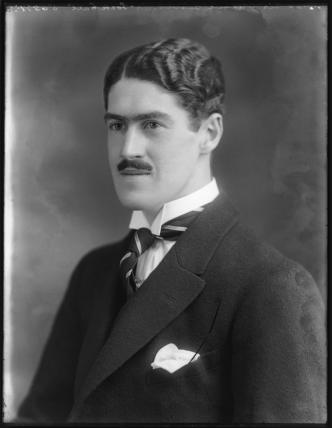
Lieutenant Sir Graeme Duncan Power Sinclair-Lockhart, 12th Baronet from a Photo by Bassano, whole-plate glass negative, 16 June 1920 (National Portrait Gallery, London. Given by Bassano and Vandyk Studios, 1974.
Sir Graeme Duncan Power Sinclair-Lockhart (b. 29 Jan 1897 in New Zealand – deceased 15 Feb 1959) was the 12th Baronet of Stevenson (County Haddington, Nova Scotia, Canada), a title that dates back to 18 June 1636and was awarded by King James I of England. Sir Graeme was the son of Sir Robert Duncan Sinclair-Lockhart (b.1859-d.1918), the 11th Baronet and Flora Louisa Jane Beresford Power. Sir Graeme was educated at Wanganui Collegiate New Zealand (1911-1915) and was working on a sheep station on the East Coast of New Zealand on the outbreak of WW1. He enlisted in 1916 in the New Zealand Mounted Rifles as a Trooper #31096. His occupation is listed as Shepherd and he embarked from New Zealand on 5 December 1916 as part of the 20th Reinforcements (First Section), NZMR, leaving Wellington on HMNZT70, the “Waihora” for Suez and joining up with the 11th Squadron of the New Zealand Mounted Rifles. He was invalided after the Gaza Battle and an article about him mentions “he again associated himself with station interests” – one surmises that this was in New Zealand.
Sir Graeme’s father, Sir Robert Duncan Sinclair-Lockhart, the 11th Baronet and who was associated with the banking business in New Zealand, died suddenly in 1918 during the time of the influenza outbreak. His obituary from 14 November 1918 states “Died suddenly at his residence, Upland Rd, Remuera, yesterday. Sir Robert, who was 58 years of age, was a son of the late Mr George Duncan Lockhart and on the death of his uncle in 1904 he succeeded to the baronetcy. His estate is at Castle Hill, Lanark, Scotland. He also held the baronetcy of Sinclair of Stevenson. In 1895 he married a daughter of Captain Edward POWER. There is one daughter and five sons, of whom Mr Graeme D P LOCKHART, who recently returned from active service, is heir to the title. At one time Sir Robert was a member of the auctioneering firm of Wakelin and Crane, Whangarei, from which he retired on assuming the title. The deceased was greatly interested in all forms of sport and was a keen yachtsman and polo player. As a member of the Pakuranga Hunt Club he was a regular follower of the hounds. He was a steward of the Auckland Racing Club and also a member of the committee of the Auckland A & P Society. He is survived by Lady Lockhart and their family.
Sir Graeme succeeded to the title. At this time he apparently proceeded to Scotland to look after the estates to which he had succeeded (which included 6,500 acres of farmland on the Clyde, a coal pit which was leased out and which also included the position of head of the Sinclair of Caithness Clan. A newspaper article dated 22 October 1920 records him as a “Fresher” attending Pembroke College, Cambridge University although how long he attended university is questionable as a further newspaper article dated 5 May 1921 (http://paperspast.natlib.govt.nz/cgi-bin/paperspast?a=d&d=HNS19210505.2.45) records that he “arrived in Sydney recently” on the SS Morea on his way home to New Zealand where his mother and brothers resided after he was forced to sell half the estate to cover British death duties. The article also mentions that he had taken leave from the “Scottish Horse” in which he held the rank of Lieutenant, having been recommended for a commission by the Duke of Atholl (note: actually it would have been the Lovat Scouts – the London Gazette of 1 February 1921 records that Sir Graeme was appointed a 2nd Lieutenant in the 2nd Lovat Scouts, a Territorial Army unit, effective 6th November 1920).
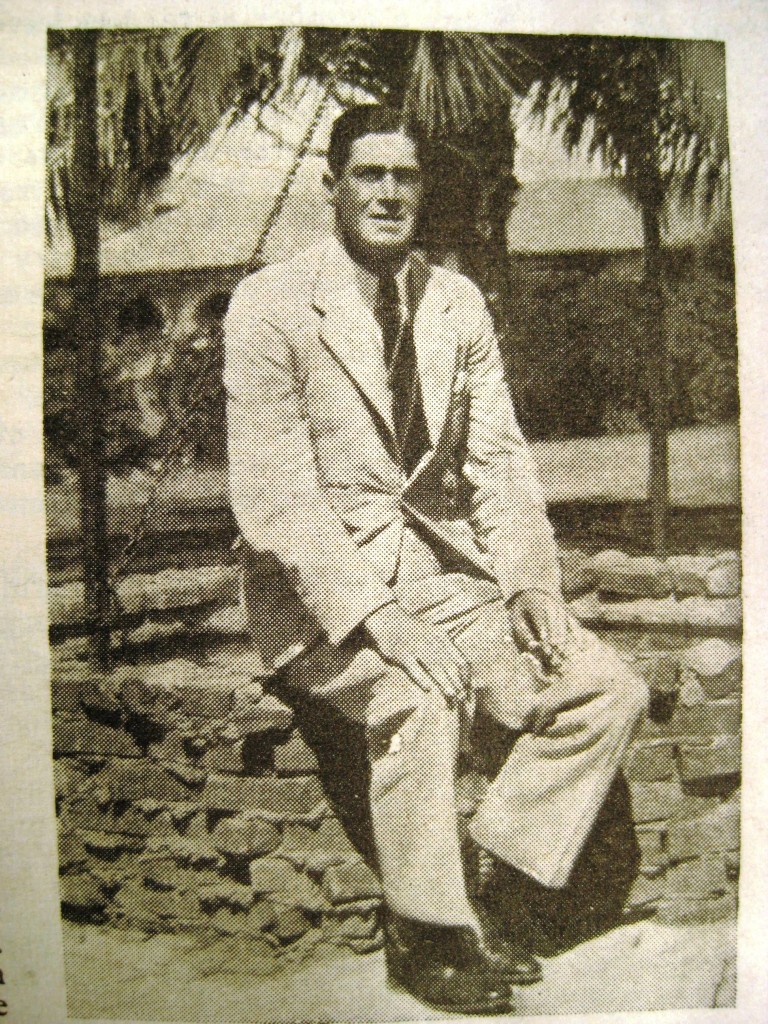
Sir Graeme in the Soth Seas, approx. 1927-29
It seems likely that he remained in New Zealand for some time as in 1928, when he was arrested and charged in Auckland for being intoxicated in charge of a motor car and fined fifty pounds, Sir Graeme’s address is recorded as Mountain Road, Remuera, Auckland, New Zealand and his Clubs as the Caledonian and the R.A.C. ([url]Ref: http://paperspast.natlib.govt.nz/cgi-bi … –1—-2–[/url]). From a 1952 story he wrote that was published in the The Wide World Magazine (“The Black Pearls of Fatu-Hiva – A weird story from the South Seas as told by Sir Graeme Sinclair-Lockhart”) he discloses that he spent three years pearl-fishing around the Tuamotus and Society Islands. The year 1928 is mentioned and the photo to the left of Sir Graeme appears.
Sir Graeme married Jeanne Hamilton FERGUSON, only child of Capt. John Ferguson on 9 May 1932 (they were divorced in 1947). The Glasgow Herald of 8 July 1932 mentions that “Sir Graeme and Lady Sinclair-Lockhart have been spending a few days quietly at Beechlands, Cathcart, the home of Mr. Andrew Mitchell, before setting off for Spain. It is only a few months since Sir Graeme Sinclair-Lockhart married Miss Jeanne Ferguson of Glasgow, and it is unfortunate that their first year of married life should have been made anxious by illness. Sir Graeme is at present recuperating from a rather nasty bout of pneumonia.” In 1936, the couple were recorded in the Miami News (29 March 1936) as attending the spring races at Tropical Park, viewing from the Presidential Suite box with a party of guests including a number of american socialites and three British Naval Officers from HMS Dundee.
Sir Graeme volunteered to fight in Finland in the Russo-Finnish Winter War of 1939-40 and was in Finland with the British Volunteers when the war ended. On the 15th Feb 1940 the London Gazette mentioned that he is transferred from the Scouts (Scottish Horse) retaining rank and seniority. Not a particularly imposing Officer and, at the age of 43, rather old for front-line service,
ATL, Lieutenant Sir Graeme Sinclair-Lockhart was appointed Intelligence Officer, a role he filled competently given that he merely acted as a conduit for Intelligence from the Maavoimat to Wingate, Tulloch and the Rifle Company CO’s. He served for the duration of the Winter War and would remain in Helsinki after the War, where he was attached to the British Embassy as a Military Attache, a role he filled competently. Perhaps in recognition of this, The London Gazette of 16 Feb 1943 records 2nd Lieutenant Sir Graeme D P Sinclair-Lockhart (47418) as transferring from the Royal Artillery to the Intelligence Corps as of 17th February 1943, retaining his present seniority. He served as a Captain in Intelligence, posted to the Embassy in Helsinki, from 1943 to 1947. He would also write articles for the British newspapers about Finland through to the end of WW2, one of which is reproduced below.
OTL Note: s far as additional information goes, there are three mentions of Sir Graeme in the book by The Volunteers: The Full Story of the British Volunteers in Finland, by Justin Brooke (ISBN 1 85421 084 X). Copies available second hand online only, as it was published in 1990 (Justin Brooke was one of the Volunteers). The first reference to Sir Graeme in the book is P65 (Captain
Chandor….found that under his command he had Baronets who would not accept responsibility or a stripe….) which I conclude is a reference to Sir Graeme. The unit of volunteers were training in Lapua in central Finland when the Winter War ended. Many of them volunteered to stay on in case fighting broke out again but after some months when this had not happened, the unit was disbanded and the volunteers then found themselves stuck in Finland, some for a considerable time before they managed to get back by various routes to the UK. Many ended up in Sweden for some months or years (this being what happened to Sir Graeme). The next mention is P73. In addition, G Sinclair-Lockhart appeared in the uniform of a lieutenant in the Finnish Air Force Reserve, without it having been mentioned in the daily orders of the Commander-in-Chief that he had been taken into the Air Force. He was given a rail warrant and rejoined the unit at Savonlinna as a private. P190 – Sir Graeme was one of the last nine volunteers who left Kalhyttan in May 1942 (they were flown out in small numbers on the diplomatic aircraft that flew between the UK and Sweden),
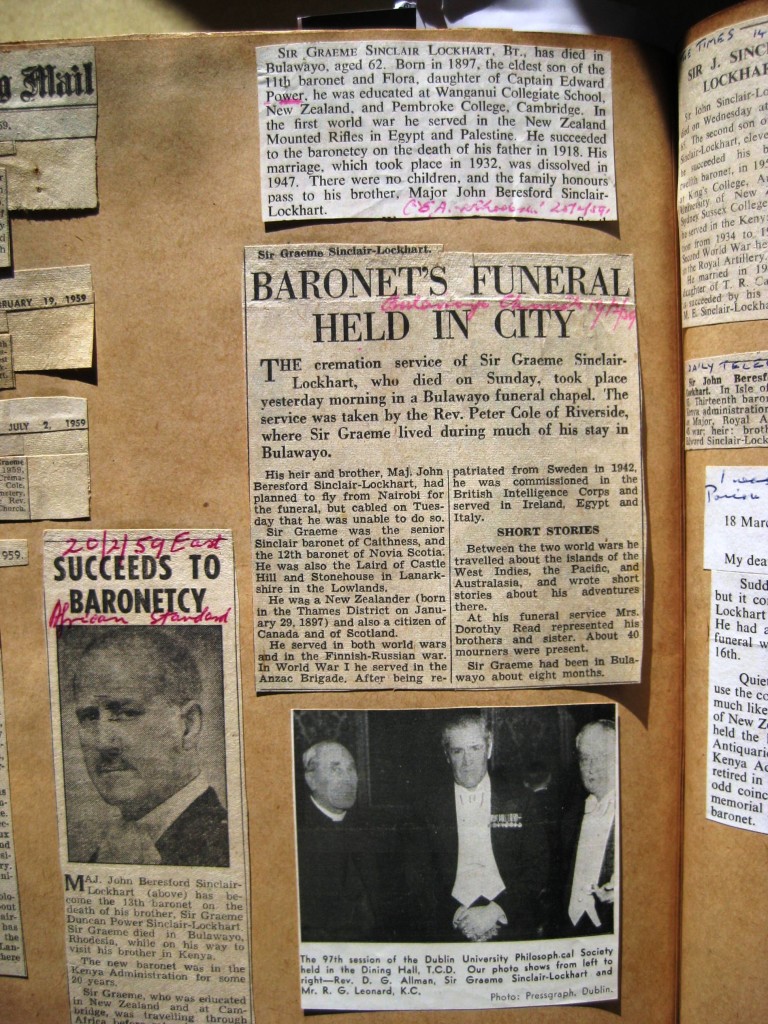
Sir Graeme Obit from 1959
FIGHTING FINNS. Described LONDON, Jan 3 1945.–Sir Graeme Sinclair-Lockhart who is well known in Australia and New Zealand, has returned to Britain briefly from his posting in Helsinki to brief the War Office on conditions in Finland and the fighting prowess of our Finnish Allies as they fight their way into Poland. In an interview he depicted Finland as determined to play their part in the defeat of Germany but also wary of Russian intentions. In liberating the Baltic States and Poland, he said, “the Nazis have used the peoples of the Baltic States to help them continue the war against Russia and have stripped everything of value from these countries to help equip Hitler’s army. In the Baltic States and in the areas of Poland that the Finnish and Polish Armies have liberated, conditions are appalling. Starvation and disease are sweeping the country and a large percentage of its manpower has been destroyed. Civilians were living on black bread. Porridge and meat were unobtainable. As well as fighting the Nazi’s, the Finnish Army is doing its best to assist civilians in the liberated areas but more help in this aspect of the war is needed. What conditions are like in the areas still under Nazi control today I cannot imagine.”
Sir Graeme’s wife divorced him in 1947 – “AUCKLAND. — The unusual case of the wife of a Scottish baronet, Lady Jane Hamilton Sinclair Lockhart, obtaining a divorce from her husband, Sir Graeme Duncan Power Sinclair-Lockhart of Lanark, Scotland, in a New Zealand court was heard in Dunedin. A divorce was granted on the ground of desertion. The action was undefended. The reason it was heard in New Zealand was that the respondent was born and spent his youth in the Dominion, which is his domicile of origin. The wife, who was born in Glasgow, acquired her husbands nationality on marriage.” A last fleeting reference to Sir Graeme is found in February 1952, as the author of “The Black Pearls of Fatu-Hiva – A weird story from the South Seas as told by Sir Graeme Sinclair-Lockhart” in The Wide World Magazine. In the story
Sir Graeme Duncan Power Sinclair-Lockhart passed away in 1959 at the age of 62 in Bulawayo, Southern Rhodesia. A true adventurer in all senses of the world.
Lieutenant Alfred Basil Brailsford “Basil” Woodburn, Platoon Commander, “F” Company
Alfred Basil Brailsford “Basil” Woodburn was born on 2 November 1910. He married Audrey Rosaline Bateman-Champain, daughter of Brig.-Gen. Hugh Frederick Bateman-Champain and Dorothy Gertrude Arbuthnot, on 22 June 1937. He volunteered to fight in Finland with the British Volunteers in the 1939-1940 Winter War and was appointed Lieutenant, albeit he had only limited military experience in the TA (Territorial Army). After returning to Britain, he served in the Black Watch, posted to 1st Battalion The Kings Regiment (Liverpool) (77 Indian Infantry Bde) with the rank of Lieutenant (Regimental#321337), where he ended up fighting in Burma with the Chindits, agains under the overall command of Orde Wingate.
In the fighting in Finland in 1940, Woodburn was awarded the Suomen Valkoisen Ruusun II lk:n mitali – SVR m. II (Medal of the White Rose (of Finland) 2nd Class). The recommendation was dated 29 May 1940 and reads “Action for which commended: From the morning of 22 May until 1200 hrs 24th May this Officer with his platoon were given two positions to hold, a counter attack to accomplish, and were used to cover the withdrawal of other troops through a position they were holding. During these various engagements, the strength of this platoon was cut down by casualties to 1 Officer and 10 men. Throughout this time the courage and leadership shown by this Officer was an example not only to his own platoon but to neighbouring units. Seldom could a higher example have been shown.” A further citation by the Finnish Fire Control Officer attached to “F” Company reads: “This officer with only ten men was ordered to counter attack up the side of a ridge that had been overrun by the enemy. With great courage he led the men himself and reoccupied the position. On 25th May he was filling a gap on the ridge between two other platoons when the enemy attacked. By his steadfast and personal courage he held his men together on the position until ordered to withdraw.”
Almost 4 years later, Woodburn would be awarded the Military Cross under similar circumstances in the fighting in Burma. The London Gazette of 3 June 1952 mentions that B. B. WOODBURN, M.C. (321337), from. Active List, to be Capt., 15th Jan. 1952, retaining his present seniority, indicating that in 1952 he was still in the Army. A further mention is found in The London Gazette of 27 Dec 1960 A. B. B. WOODBURN, MC (3121337), having exceeded the age limit, ceases to belong to the TA. Res. of Offrs., 28th Dec. 1960, and is granted the hon. Rank of Capt. The last mention found is from 4 May 1980, when Capt. Woodburn and his wife were murdered in South Africa, he at the age of 69, she at the age of 65.
Lieutenant Martin Edward Meakin Herford, Medical Doctor, CO Medical Platoon and Battalion Medical Officer, Atholl Highlanders
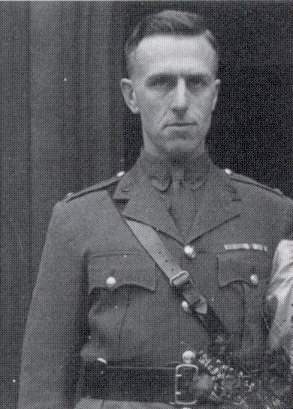
Lieutenant-Colonel Martin Edward Meakin Herford (1909 – 2002). By late-1944 he had been promoted from Lieutenant to Lieutenant-Colonel over a 4 year period and had distinguished military career behind him in Sicily and Italy. He was now the Commanding Officer of 163 Field Ambulance, had been awarded a Bar to his Military Cross early in 1944 to accompany the MBE he received earlier in the war. His Field Ambulance Unit was part of the ground forces attempting to reach Arnhem.
Martin Edward Meakin Herford (1909 – 2002) was a military doctor, pioneer in the occupational health of young workers. He was the second son of Oscar and Ethilda Herford who married in 1907. His father was a businessman based in Calcutta, India who was of German Jewish origins, with the family name of Haarbleicher. When anti-German feeling became extreme at the time of WW1, the family changed its name to Herford. His mother was born 6 December 1872, the daughter of Edward Meakin and Sarah Ann Budgett and died 26 Aug. 1956. Her Who’s Who entry gives her profession as “Hon. Physician, British Hospital for the Treatment of Mental Disorders; Hon. Physician, London Clinic of Psychoanalysis; Psychological research, Maudsley Hospital; Psycho-therapist (consultant).” Martin Herford gained his Bachelor of Medicine” degree (MB) and MD designation in 1937 in Bristol. After qualifying as a Doctor, he travelled to Spain to work with children suffering from starvation as a result of the Spanish civil war. After returning to the UK, he volunteered to serve in Finland with the British Volunteers, arriving in Finland in early March 1940 with the bulk of the Battalion. He was the only Medical Doctor among the volunteers and as such was appointed Battalion Medical Officer and CO, Medical Platoon, a role he rapidly grew into and filled with great competence for the duration of the Battalion’s sojourn in Finland.
He would return to the UK in January 1941. On 22 January 1941 he was commissioned into the Royal Army Medical Corps (RAMC) as a Lieutenant (emergency commission, Regimental # 175256). He was immediately posted to Egypt, where he worked in the General Hospital (Helmieh, Egypt) to 27 Feb 1941, at which time he was posted to the Casualty Clearing Station RAMC (Greece) (liaison and evacuating British troops) through to May 1941. Returning to North Africa, he was promoted to Second-in Command, 7 Motor Ambulance Convoy RAMC (Western Desert, North Africa). On 22 January 1942 he was promoted to Captain and appointed Acting/Major and Commanding Officer, 16 Motor Ambulance Convoy RAMC (Western Desert, North Africa, wounded 23 July 1942, hospitalized & posted to 15 (Scottish) General Hospital 9 November 1942), holding the post until April 1943. In April 1943 he took command of 200 Field Ambulance RAMC (attached to the 231st Infantry Brigade in Sicily and then in Italy), holding this command until May 1944. From May 1944 to August 1945 he was Commanding Officer, 163 Field Ambulance RAMC – while holding this command, he was confirmed in the Rank of Major on 22 August 1944 and at the same time given the Rank of T/Lt.Col.
Lt-Col. Herford, although not an Airborne soldier, played a critical role in the establishment of the “Airborne Hospital” at Apeldoorn, near Arnhem during the Battle and in the month afterwards which saved the lives of many Airborne soldiers, along with some civilians and German personnel. On 24 September 1944, he was granted permission to organise an attempt to get urgently needed medical supplies over the Rhine to Oosterbeek, accompanied by Capt Percy Louis from HQ Airborne Corps, and four ORs from 163 Field Ambulance. Although this supply mission ultimately failed, his presence in Arnhem was vital in co-ordinating Medical Services for the wounded (Cpt Louis would later drown attempting to re-cross the Rhine to Allied lines, whilst the ORs were captured shortly afterwards). The relief attempt began in daylight displaying a Red Cross flag to the south bank of the river, where they found an abandoned assault boat and paddled across the Rhine. Reaching the north bank safely, Lt Col Herford went forward to ‘reconnoitre’ and soon ran into some Germans troops who captured him. Over the next few hours he met various German officers at different locations before reaching a German HQ in Ede.
Lt Col Herford was instructed to go Apeldoorn to visit the Chief Regional Medical Officer, Lt Col Zingerlin, by the German HQ at Ede. On 25 September Herford arrived in Apeldoorn. Zingerlin informed him that many wounded British soldiers were expected as a result of a truce that had occurred in Oosterbeek which allowed the evacuation of wounded. The German occupied hospitals were already pretty full and Zingerlin took Herford to a pre-war Dutch Army base, the Willem III Kaserne Barracks, where he suggested around 250 lightly wounded Airborne troops could be treated. Lt Col Herford later said he suggested the Barracks should be made a ‘British Hospital’ and staffed by British medical personnel, which Lt Col Zingerlin agreed to. The British personnel were happy with this idea, as it was hoped the 2nd Army might soon secure a bridgehead on the North Bank of the Rhine nearby and soon relieve Apeldoorn, although this Allied advance would ultimately fail to materialise. Later on the afternoon of 25 September, casualties began pouring into the barracks and were being laid in rows upon piles of straw. As Lt Col Herford was unknown to any of the Airborne officers he was initially treated with some suspicion – a possible ‘stool pigeon’ planted among them by the German Intelligence Services. It soon became clear however that he was genuine. His fluency in German proved invaluable to help overcome numerous differences of opinion.
When the Divisional ADMS, Col Graeme Warrack, arrived at around 1900 hrs on 26 September, and assumed command, he established an HQ, and retained Lt Col Herford as his Second-in Command. Herford remained as an integral part of the Hospital until he, along with several other Officers, escaped during a night of bad weather on 16 October 1944. Herford escaped by swimming the Rhine and with him brought the names of all the wounded British soldiers. He went on to organise medical services at Belsen and was awarded a Distinguished Service Order in March 1945 for his actions at Arnhem and in North West Europe. After the war, he remained in the Royal Army Medical Corps and rose to become an Acting Colonel (31 August 1945) and a full Colonel in the TA in 24 February 1950.
After the war he studied occupational medicine in the United States and on his return to the UK, worked in the field. Predeceased by his wife, Mary, he left three daughters and nine grandchildren.
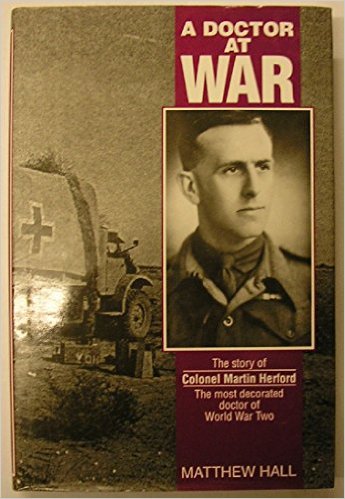
A Doctor at War: Story of Colonel Martin Herford – The Most Decorated Doctor of World War Two
The author of “A Doctor at War”, M R Hall, comments in the updated forward: “Now and again one has the privilege of meeting someone truly inspiring. I had such an encounter in 1995 with the then eighty-six year-old Colonel Martin Herford, the most decorated British doctor of World War Two. I was a twenty-seven year-old lawyer trying to become a writer of fiction, but as fate would have it, my first published work would be in the realm of non-fiction; through a series of coincidences I had landed the job of recording this remarkable man’s wartime experiences. It’s fair to say that scarcely a month has passed in the intervening years in which I haven’t thought about what it must have been like for him to serve first in the Spanish Civil War, then in Finland, then in every major theatre of war right through to the liberation of Belsen. There can have been very few men who saw as much of the world’s biggest and most devastating conflict as Colonel Herford, and who emerged so philosophical and faithful to their principles. He was a living testament to the efficacy of Churchill’s famous maxim: ‘When you’re going through hell, keep going.’
At a time when ephemeral culture is finally showing signs of giving way to more sober and thoughtful perspectives, I feel we may need the stories of men like Colonel Herford more than ever: like the war-time years, those ahead promise to require inspired and outstanding individuals to subordinate their egos to vast group efforts. Virtue may once again have to suffice as its own reward. The following pages are a simple account of Colonel Herford’s war written by a young man who scarcely appreciated the enormity of what he was setting down. But what I did understand even then was that the doctors, nurses and stretcher-bearers of the military are every bit as courageous as the front-line troops, and very seldom written about. The image of a team of medics tucked safely away in a hospital tent well behind lines is far from accurate. Very often the wounded were treated in the midst of battle with bullets flying and shells exploding all around. Were it not for the efforts of the thousands of Medical Officers and staff who accompanied the Allied armies throughout battles across three continents, the fatalities would undoubtedly have been far higher.
When it came to discussing his experiences, Colonel Herford proved to be a modest man with an admirable reserve typical of the wartime generation. Self-aggrandizement was definitely not his style. Consequently it wasn’t always easy to extract detail from him – especially that concerning his own acts of heroism – but thankfully he had an old leather suitcase full of diaries, letters, notes and official dispatches through which I sifted in an effort to distill the unembellished facts. I am glad to say he gave his full approval to the finished text. When I cast back my mind nearly seventeen years I remember a man full of dogged but peaceful spirit. After dinner in his farmhouse on the Cornish coast, he led me outside and pointed out the constellations in a perfectly clear night sky. Despite all he had witnessed, he remained in awe of God’s infinite creation, and ever respectful of it.”
Godfrey Millington-Hogg
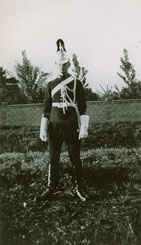
Godfrey Millington-Hogg served with the Governor General’s Horse Guard. He enlisted in 1936 and escorted King George VI and Queen Elizabeth on their tour of Canada in 1939.
Godfrey Millington-Hogg was a Canadian (born in Britain) who was in London, England when the war started in September of 1939. “I remember sitting on the front steps at my Aunt Clara’s when the sirens went off for the first time and all were ordered down to the basement. No one went but just stood around outside.” Millington-Hogg had joined the militia at the age of 17 as a member of the Mississauga Horse Regiment in Toronto. He did not receive pay for belonging to regiment but it allowed him to spend time with horses and compete in equestrian competitions.
“In 1940, I volunteered to go to Finland, because the country was looking for volunteers. I was interviewed, asked about my military service, etc. I was then sent to a building in Soho on Greek St. and I spent about one month there. I left on the first boat. They only took three quarters of us that signed up.” Millington-Hogg was assigned to “E” Company and survived the fighting in Finland where a good number of his comrades did not.
OTL Note: “In 1940, I volunteered to go to Finland, because the country was looking for volunteers. I was interviewed, asked about my military service, etc. I was then sent to a building in Soho on Greek St. and I spent about one month there. I left on the first boat. They only took three quarters of us that signed up. The police took the rest away as they were criminals trying to escape England. I was attached to the Air Force and an infantry unit of the Army in Finland. In 1941, Germany sent troops into Finland and we were sent to Sweden despite German authorities’ plans to lock up all foreigners.” He was training to be an airgunner in the Finnish airforce when the Winter War ended. He like many other volunteers from England were moved to Sweden . Here he was able to get a diplomatic flight out in 1942 to England . The previous flight was shot down by the Germans for some reason. He wound up as a tank commander through Italy and northern Europe Holland and into Germany.
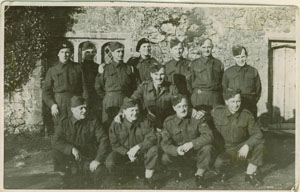
Godfrey Millington-Hogg is in the back row at the far left.
“By the time I got back to England in the late summer of 1942, I learned that my mother received a telegram saying that I was dead and she did not recognize me when I appeared at her door. After being back in England for a month, I tried to enlist in the Canadian Army. It was a complicated process because I had been away from Canada for a few years and still retained my British citizenship from birth. Thankfully, I met up with the commanding officer of the Mississauga Horse Guards at the Canadian Army Reinforcement Station who remembered me from my time in the militia and helped move the process along. After participating in a sanitary course, commando course, and building projects, I was sent to Sicily. The only injury of this part of the war that I remember was when I was stationed in Foggia Italy. I was instructing gunnery on tanks. I was standing somewhere on the tank, I gave a command to turn the big gun left and the new recruit turned the gun to the right, catching my foot. It turned the sole of my boot to the top of my instep. The foot started to swell and someone helped me back to the medic but no doctor. I lay down in my tent for two days but still couldn’t stand. After being sent back to base to recuperate for a month, I ended up with yellow jaundice and was shipped to a hospital on the Adriatic.
After recuperating, I rejoined my regiment and we fought through Italy and Belgium before ending up in Holland for the end of the war. During our last battle of the war, we were bedded down in a farmhouse. I was in a room facing the back of the house. The German troops attacked. All the officers were in an old school house while the Germans went down the street. We were backing up the Irish Regiment that day. The Irish Regiment had 15-20 men dead. I pulled my tank across the laneway where there was a hedge on the right hand side which was about 200 yards away. The hedge connected to another hedge row. I saw Germans moving around over there and I was the only tank in position so I started firing. The Germans surrounded the town and were running up and down the streets but didn’t go into the school house where the officers were meeting. With no officers with them to give orders, my tank started shooting 303 ammo at the hedge. The gunner wasn’t well trained and kept his finger on the trigger causing the barrel to overheat. When the barrel gets so hot the barrel whips around so there’s no accuracy at all. We used up 4 barrels this way. When it was getting daylight and the officers were coming back to where the men were, an officer started giving me hell because of destroying all the gun barrels. Then a man from the Irish Regiment walked up and said, “Well done.” We took many German prisoners that day and this was the last battle which was a week or so before the war stopped.
Captain Rex King-Clark – Rifle Company CO – “C” Company
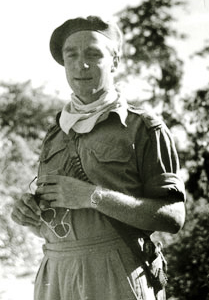
Captain Rex King-Clark, Finland, Summer 1940
Robert “Rex” King-Clark MBE MC (born 27 November 1913; died 29 December 2007) was a British soldier, pilot, racer, photographer, author, and diarist. Rex King-Clark was born on 27 November 1913, son of Alexander King-Clark (a London stockbroker who was killed in action 2 weeks before the end of WW1) and Katherine Margaret Elizabeth Mainwaring Knocker. After prep school in Sussex, Rex went to Loretto School, Edinburgh with his brother Cuffy. From Loretto ‘Rex’ went on to Sandhurst where to his considerable surprise he became a cadet sergeant and gained a Blue for Fencing, going on to win the Inter-Services Foil at the 1933 Royal Tournament. Like many Loretto boys (as opposed to those from English public schools) he did not find Sandhurst over arduous. As he was later heard to say, “I never even got beaten there”, a not uncommon occurrence at Loretto. In February 1934 Rex was commissioned into the Manchester Regiment. This was through the influence of his sister’s father-in-law, Sir John Maclure, an ex-officer of the Manchester’s who served on the Regimental Council. He joined the 2nd Battalion, The Manchester’s at Strensall serving with them until 1937 when he joined the 1st Battalion in Egypt and on to Palestine and Singapore.
In 1934 an inheritance enabled him to channel his surplus energy and enthusiasms into other fields as well. He flew his Miles Whitney Straight airplane as far as Egypt, Singapore, and Bali. During March 1937 he flew aerial reconnaissance flights of the harbor at Benghazi, North Africa, taking photographs which were later used by the Royal Air Force during World War II. He toured Europe and America by car and raced his J4 MG at Brooklands which made him to become a member of the prestigious British Racing Drivers’ Club. In 1938 during the “Troubles” in Palestine he commanded one of Orde Wingate’s three Special Night Squads, the SNS of Israel folklore, where he fought against Arab Terrorists in the steep Galilean Hills of Northern Palestine. He was awarded the Military Cross and a certificate of Gallantry for this work. One Sergeant and ten other ranks from the Manchester Regiment were with him, together with a number of Jewish soldiers with whom he remained friends for many years. His diaries of his pre-war adventures formed the basis for his autobiographical book Free For a Blast, published in 1988.
In 1937 Rex had applied for a four year secondment to the Royal Air Force and this was approved in March 1939. On arrival in England Rex went along to the War Office where he was told that he had never been heard of and that he was to return to his Battalion in Singapore after his leave was finished. Eventually this was sorted out and he was “attached to the 2nd Battalion of the Regiment, Aldershot, pending attachment to the RAF”. However on the 1st September 1939 his pending attachment was cancelled and he was instructed to return to The Manchesters. When his old friend Jack Churchill volunteered to fight in Finland under Orde Wingate (whom he knew very well indeed) and mentioned this to King-Clarke, King-Clarke immediately volunteered as well. Wingate accepted him immediately and as an Acting Captain and with combat experience under Wingate in Palestine, he was appointed Company Commander, “C” Company. He would be wounded in action in the fighting in Finland but would also, to his joy, fly Gliders in the assault landings that the Atholl Highlanders participated in on the Karelian Isthmus and would later fly one of the Fiesler Storch light liaison and observation aircraft that the Maavoimat used
After returning to Britain, he would be posted to India, promoted Captain in 1942 and would go on to command the 2nd Battalion The Manchester Regiment during the Battle of Kohima fought on the Burma/India border from April to June 1944, despite being wounded on 24 April. He wrote two books from his diaries of those times, The Battle for Kohima, and Forward From Kohima. He was promoted to Major in 1947 (although he was already acting in that rank). Rex finally achieved his flying ambition and commanded the Glider Pilot Regiment in the UK between 1949 and 1952. He married Jean May Evelyn Campbell, on 16 January 1950. They had two children, Robert Campbell King-Clark (born 28 October 1950), and Catherine Mainwaring King-Clark (born 30 October 1952). He went to Korea where he served as Deputy Assistant Adjutant and Quartermaster General (DAA & QMG) of 28 British Commonwealth Brigade. He then returned to The Manchester’s in 1953 in Berlin as Second in Command. His last military job was as General Staff Officer 1 (GSO1) Land/Air Warfare Directorate where he played a major part in the formation of the Army Air Corps. He retired from the Manchester Regiment with the rank of Lieutenant Colonel in 1958 and died in 2007 at the age of 94.
Major H. E. N. “Bala” Bredin – Rifle Company CO – “D” Company
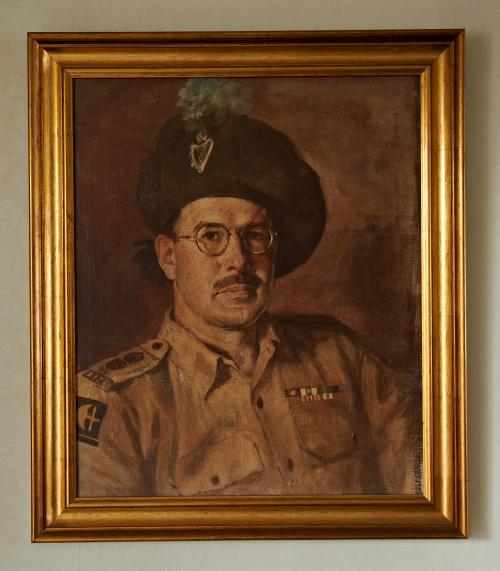
Lt. Col Bredin: Reproduced courtesy of the London Irish Rifles. He never wore a steel helmet and was a conspicuous figure in his regimental feathered bonnet, and carrying a cane. A soldier who was constantly making jokes, he affirmed, was worth his weight in gold, for it took men’s minds off the appalling scenes around them.
Humphrey Edgar Nicholson ‘Bala’ Bredin CB, DSO and two Bars, MC and Bar (b. 28 March 1916; d. 2 March 2005) was a British soldier whose military service took him from 1930s Palestine, Finland, North Africa and Italy to the Cold War in Germany. The second son of Lieutenant-Colonel A. Bredin, of the Indian Army, “Bala” Bredin was born at Peshawar on the Northwest Frontier on March 28 1916. He was educated at King’s School, Canterbury and at the Royal Military Academy Sandhurst after which he was commissioned into the Royal Ulster Rifles in 1936. He was following in a long family tradition of military service, for his forebears had fought on both sides at Agincourt in 1415. Both his father and grandfather were in the Green Howards, and two of his uncles had served in the Royal Irish Regiment. While at Sandhurst, Bredin acquired the nickname “Bala”, which was the name of a fort in Peshawar and also the name of a successful horse owned by the Aga Khan. On being posted with the Ulster Rifles to Palestine, he found himself quartered in an Arab village called “Bala”.
During the 1936–1939 Arab revolt in Palestine Bredin was a subaltern (2nd Lieutenant) with the 2nd Royal Ulster Rifles in Upper Galilee. The Army was charged with protecting Jewish settlements and tracking down Arab insurgents. Bredin took part in counter-insurgency patrols under the command of Major (later Major-General) Orde Wingate as part of Wingate’s Special Night Squads. He won his first MC for a successful patrol attack against superior numbers at a notorious ambush point on the Tulkarm-Nablus road, in April 1938, and a second a month later in a similar action. The citation noted that “he had already proved adept at this work which is both arduous and dangerous”. While patrolling with a squad of soldiers and police supernumeraries on the night of June 11 1938, he saw a party of Arabs setting fire to the oil pipeline; he attacked them, promptly inflicting casualties and making arrests. Three weeks later he was leading five soldiers on patrol when they encountered a much larger gang astride the oil pipeline which he attacked and drove off, killing and wounding several. In another action a few days later he engaged a large enemy party which he chased part of the way up Mount Tabor. In spite of being wounded, Bredin remained on duty till the end of the action.
In 1939, as the threat of war with Germany loomed, units of the British Army, including the Royal Ulster Rifles, returned to the UK and when war broke out, they moved to France. Bredin was about to leave with his unit for France when Wingate took over the Atholl Highlanders and asked for him by name. Bredin was at first loath to volunteer, preferring to stay with his Battalion, but Wingate was pressing and Rex King-Clark and Jack Churchill, both of whom Bredin knew well, convinced Bredin to join them, a move he never regretted. Wingate promoted him to Acting Major and gave him command of “D” Company, a position he held throughout the Winter War. An experienced soldier and officer with combat experience from Palestine, Bredin trained his men hard and ensured they made the most of the Maavoimat training after they arrived in Finland.
After the Karelian Isthmus offiensive of Spring 1940, Bredin received the Cross of Liberty 2nd Class, with swords . The citation said: “Major Bredin commanded D/AH (D Company of the Atholl Highlanders) during the period 12-25 April ’40 when 21st Pansaaridivisoona advanced on the Karelian Isthmus. This Company was dropped in advance of the 21st Div by and was affiliated to the Parajaegerdivisoona. On four occasions over a three week period, the Atholl Highlanders were launched by glider to land in advance of the leading elements of the 21st (Pansaaridivisoona) in order to secure strategic objectives and to exploit battlefield success. On each occasion, outstanding results were achieved, the enemy’s defences being overwhelmed, objectives seized and havoc and confusion caused in the enemy’s back areas. In particular, on April 18th, D Company under Major Bredin’s command was launched in advance of the main attack (Map Reference 237651) and executed a dashing seizure of a strategic bridge 10,000 yds (yards) in the enemy rear, capturing the bridge (Map Reference 246677) from the SW (south-west) and then securing and holding the bridge against Red Army counter attacks until advancing armoured units relieved the Company. In the action, medium arty (artillery) was overrun, tanks, and anti-tank guns destroyed or captured and many Red Army soldiers killed.
Again, on 21 April, D Company dropped by glider in the late afternoon and after regrouping, in bright moonlight seized a bridge (Map Reference 191820) and nearby road junction (Map Reference 213823) 8,000 yds in the enemy rear against stiff opposition. Again, the enemy were thoroughly disorganised and all types of equipment seized and many Red Army soldiers killed. These fine successes in a type of operation entirely new to the participants were very largely due to the outstanding skill and powers of command shown by Major Bredin. In these fast-moving battles, he always had a thorough grasp of the situation and acted with admirable speed. Such was the confidence of his Company in his leadership that they cheerfully and enthusiastically embarked upon tasks which might have appeared foolhardy under less inspiring leadership. Major Bredin’s co-operation with Ilmavoimat Close Air Support and Maavoimat Artillery support as well as with the advancing lead elements of the 21st Pansaaridivisoona was a model of what should be done in these circumstances.”
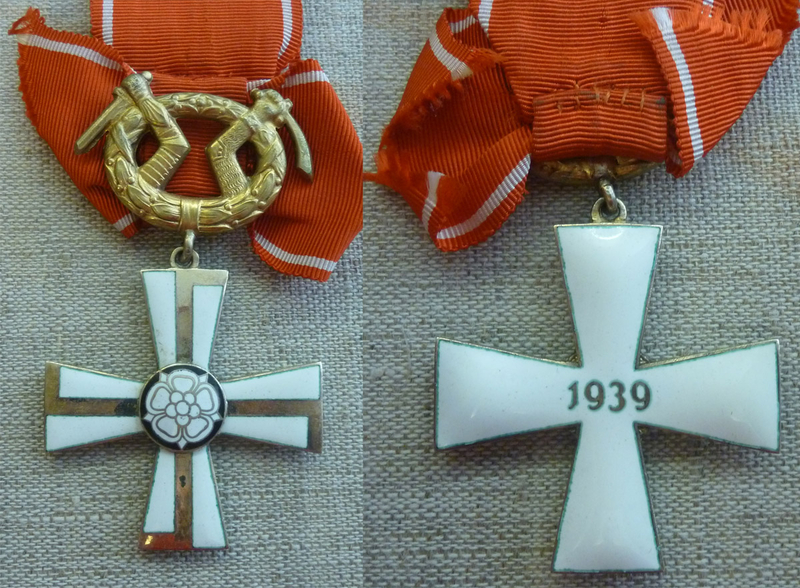
Cross of Liberty 2nd class with swords 1939 – Winter War
In October 1940, Bredin was on his way back from Finland to Britain with the Atholl Highlanders, embarking on a Finnish transport ship at Petsamo for the risky voyage back to the UK. They had just completed boarding and just as Bredin slumped down to catch up with sleep, he saw a man in a white coat. On discovering that he was a steward, Bredin inquired: “Any chance of a pint of beer?” “Yes, sir,” replied the steward, “but I can’t serve you till we are three miles out.” The ship was rolling from side to side as it reached the open sea. Eventually Bredin got his beer. “I thought to myself,” he said, “we can’t lose the war with people like that about.”
After returning to the UK, Bredin ended up volunteering for the Airborne Division and by 1943, he was Brigade Major, 2nd Parachute Brigade (1st Airborne Division). In 1944 Bredin was asked to command the 6th Battalion Royal Inniskilling Fusiliers in Italy; on May 15, he was given the task of leading 78 Division in the break through the Gustav Line, the German defences across the peninsular from the north of Naples and Termoli. “Throughout this operation he commanded his battalion with the utmost skill and inspired his men by his examples of personal gallantry under heavy fire. This difficult operation was entirely successful owing to his leadership,” ran the citation. Two days later Bredin was ordered to attack Piumarola, where German infantry and tanks had held up an advance all day. He planned the attack at short notice and was wounded on the start line; but despite his wounds he fought on with great gallantry until success was in sight, when he fainted from loss of blood and was evacuated. He was awarded an immediate DSO.
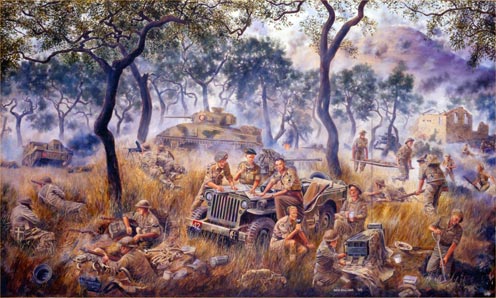
The O Group at Monte Cassino: On 15th May 1944
The O Group at Monte Cassino: On 15th May 1944, during 8th Army’s Cassino offensive, 2nd London Irish Rifles were preparing to advance when German shell and mortar fire mortally wounded the Commanding Officer. Major John Horsfall assumed command. Brigadier Pat Scott, the Irish Brigade commander, Lt-Col Bala Bredin, the CO of 6th Royal Inniskilling Fusiliers, whose battalion was already on its objectives, and Major Paul Lunn Rockliffe, commanding the supporting battery of 17th Field Regiment RA, joined Major Horsfall for an Orders Group at 1700 hours to plan the next stage of the advance. John Horsfall, who has written several books about his soldiering days, described the scene in graphic detail. The ground was full of banks and folds. Olive trees reduced the visibility forward.
“A wrecked German 56-mm anti-tank gun was dug in nearby, and an awful lot of smashed kit was lying about.’”John always wore his Sam Browne belt and leather pistol holster. Fusilier Clanachan prepares to hand him a mug of rum. Pat Scott typically smoked his pipe, as they spread aerial photos (joined up on boards) on the bonnet of a jeep. (His caubeen is now in the Royal Irish Fusiliers Museum). Paul Lunn-Rockliffe, “almost always seen wearing shorts”, was on the No.19 radio set, directing the fire of his guns; the jeep was probably his, and bears the RA tactical sign and the Battle-axe badge of 78th Division. The Regimental Aid Post was operating in the base of a once substantial building, now wrecked, and wounded soldiers were being stretchered in. A Sherman tank of 16th/5th Lancers is nearby. At left is a carrier bearing the tac sign (56) of 2 LIR, at the spot where the CO was killed earlier. Riflemen of the London Irish lie in shallow foxholes about the position.
When Bredin had recovered from his wounds, he was appointed to command the 2nd Battalion, London Irish Rifles. Mounted in Kangaroos (armoured troop carriers) and affiliated to the 9th Lancers, it was then launched through the leading elements of the enemy positions in order to exploit their success. On April 18, the battalion advanced 10,000 yards, capturing the bridges over the Fossa Sabbiosola and reaching the Scolo Bolognese. In this action enemy artillery was over-run, tanks and guns were destroyed or captured, and many prisoners were taken. Three days later the force advanced another 8,000 yards against stiff opposition, capturing more bridges and matériel. Bredin’s citation emphasised that in this fast-moving battle his grasp of a rapidly changing situation and rapid action were vital. His men had such confidence in his leadership that they cheerfully and enthusiastically embarked on tasks which would have appeared foolhardy under less inspiring command. Well aware of the horrors of the battlefield, Bredin held that preliminary discussion of expected casualties was a mistake, and that fear was best dispelled by treating war as a sort of game.
Following the war, Bredin was once more engaged in anti-terrorist work in Palestine and, after a spell as an instructor at Sandhurst, was seconded to command the Eastern Arab Corps in the Sudan Defence Force from 1949 to 1953. He next commanded the 2nd Battalion, the Parachute Regiment and would lead the Battalion when they dropped on the airfield at Port Said in November 1956 during the Suez Crisis and on Cyprus, where his leadership and planning in anti-terrorist work, mainly in the Troodos Hills, brought him a third DSO in 1957. His troops captured a large collection of automatic weapons, arms and explosives as well as important documents, and reduced four organised gangs to a number of leaderless individuals. On returning home, Bredin was characteristically outspoken about the men’s deep frustation at the ceasefire. From 1958 to 1960, Lt. Col Bredin went on to command the the 2nd Parachute Regiment.
After two years in the home posting Bredin was promoted to command 99 Gurkha Brigade Group in Malaya and Borneo. In 1962, he was appointed Chief of the British Commander-in-Chief’s Mission to Soviet Forces in Germany (BRIXMIS) for two years. From 1965 to 1968 he commanded 42nd Division (TA) and from 1967 was GOC, Northwest District. He was appointed CB in 1969. His final posting was as Director of Volunteers, Territorials and Cadets, Ministry of Defence, from 1968-71, during which time he was also the first Colonel Commandant of the newly formed King’s Division. He was Colonel of the Royal Irish Rangers from 1979 to 1984. In retirement he was Essex and Suffolk Appeals Secretary for the Cancer Research campaign, and enjoyed shooting, travelling, fishing, gardening and entertaining. A trenchant letter writer to The Daily Telegraph, he questioned cuts to the services in 1991, and protested at remarks about the cavalry by Field Marshal Lord Carver, saying that field marshals never retired because “they had to defeat the Queen’s enemies in the murky future and to harass the politicians accordingly”.
Despite his distinguished military career, in which he had been wounded with every regiment with which he had served, “Bala” Bredin stressed that he was not a warmonger, “I’ve seen too much of war to like it,” he would say. But he felt that while there were ambitious, ruthless people of every nationality, war of some form or other was probably inevitable, and that Britain should be prepared for all possible contingencies and not count on “peace in our time”. He married first, in 1947 (dissolved 1961), Jacqueline Geare; they had a daughter. He married secondly, in 1965, Ann Hardie; they had two daughters.
Major-General ‘Bala’ Bredin died died 2 March 2005 aged 88. He was awarded an MC and Bar when serving with the Royal Ulster Rifles in Palestine in 1938, the (Finnish) Cross of Liberty 2nd Class, with swords in 1940 and an immediate DSO in Italy in 1944; he won an immediate Bar to his DSO in 1945 and received another Bar to his DSO when commanding the 2nd Battalion, the Parachute Regiment, on Cyprus in 1957; he was also twice Mentioned In Dispatches, and was one of the most decorated soldiers in the British Army.
Major Jack Churchill – Rifle Company CO – “B” Company
While there were many more Volunteers who fought with the Atholl Highlanders in Finland, and many of these would men would go on to make a name for themselves in one way or another in WW2, we will restrict ourselves at this stage to covering one final Volunteer – John Malcolm Thorpe Fleming “Jack” Churchill, DSO & Bar, MC & Bar (16 September 1906 – 8 March 1996), nicknamed “Mad Jack” for reasons which will become apparent. Romantic and sensitive, Jack Churchill was an avid reader of history and poetry, knowledgeable about castles and trees, and compassionate to animals, even to insects. He was also a colorful and adventurous British military officer who volunteered to fight in Finland, stormed beaches and led attacks on enemy positions whist playing the bagpipes, who used a Scottish Claymore in battle and who once took 42 Germans prisoner at swordpoint. He may also well be the last soldier in a European army to kill an enemy with a longbow.
“Jack” Churchill was a professional soldier, the son of an old Oxfordshire family. His father, Alex Churchill, was on leave from the Far East, where he was Director of Public Works in Hong Kong and later in Ceylon when “Jack” was born on Sept 16 1906 in Surrey. After education at the Dragon School, Oxford, King William’s College, Isle of Man, and Sandhurst, Churchill graduated from the Royal Military Academy at Sandhurst in 1926 and was commissioned into the Manchesters Regiment and gazetted to the 2nd Battalion, which he joined in Rangoon. The Regiment had battle honors dating back to the 18th century, having originally been raised as the 63rd and 96th Regiments of Foot and had shed blood fighting for Britain across the world. Forty-two battalions of the Manchesters served in World War I alone. Churchill’s younger brother, Tom, also became a Manchesters officer, and in time would rise to major general, retiring in 1962. Another younger brother, Buster, opted for the Royal Navy’s Fleet Air Arm and died off Malta in WW2.
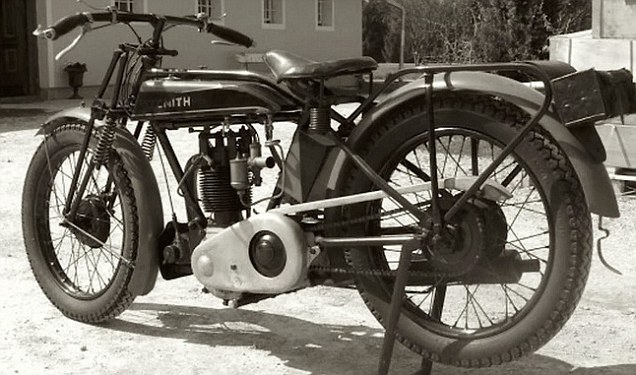
A Zenith-JAP overhead-valve single cylinder machine, of the type that Jack Churchill rode across India and Burma.
That Jack Churchill was somewhat of a “free spirit” was obvious from the beginning of his army service, even in an army rich in such men. As just one example, while serving in Burma before the outbreak of WW2, he attended a course in signals at Poona in India. It might appear odd to some that Churchill rode his Zenith motorcycle most of the way from Rangoon to Poona, but it did not seem at all remarkable, at least to Churchill, to return the 1,500 miles from Poona to Calcutta—whence he was to take a ship for Rangoon—riding his motorcycle. Along the way he lost a contest with a large and hostile water buffalo but returned to his unit in time to serve in the Burma Rebellion of 1930-32. Unusual hazards and difficulties never meant much to Churchill. On the same motorcycle he had traveled the 500 miles through Burma from Maymyo (a Hill Station in Shan State in the north of Burma) to Rangoon, a trip substantially complicated by an absence of roads. He therefore followed the railroad line, crossing the dozens of watercourses by pushing the bike along a rail while he walked on the crossties. Everything in life was a challenge to him. Included in the challenges to which he rose was mastering the bagpipe, a peculiar attachment for an Englishman. His love affair with the pipes seems to have originated in Maymyo, where he studied under the pipe major of the Cameron Highlanders.
Back in England in 1932, Churchill kept on studying the pipes, but the peacetime army had begun to pale for him. Churchill was one of those unusual men designed to lead others in combat, and such men are often restless in time of peace. And perhaps, as his biographer commented, “certain eccentricities—brought on no doubt through frustration—such as piping the orderly officer to the Guard Room at three o’clock of a morning, and studying the wrong pre-set campaign in preparation for his promotion exam, precluded any chance of promotion for the time being and made the break, after a chat with his commanding officer, inevitable.” When Churchill managed to get himself reprimanded for using a hot water bottle, a distinctly non-military piece of equipment, he circumvented this nicety of military protocol by substituting a piece of rubber tubing, which he filled from the nearest hot water tap. And then there was the day on which he appeared on parade carrying an umbrella, a mortal sin in any army. When asked by the battalion adjutant what he meant by such outlandish behavior, Churchill replied “because it’s raining, sir,” an answer not calculated to endear him to the frozen soul of any battalion adjutant.
But when the regiment returned to Britain in 1936, he became bored with military life at the depot at Ashton-under-Lyne and for whatever reason, after 10 years of service Churchill resigned his commission and turned himself to commercial ventures. A job on the editorial staff of a Nairobi paper did not please him, and so he turned to other tasks. Among other things, he worked as a model in magazine ads and as a movie extra. He appeared in The Drum, a movie of fighting on the Northwest Frontier in which he played the bagpipes. And because he had rowed on the River Isis, he won a cameo in “A Yank At Oxford”, in which he pulled the bow oar in the Oxford shell, with movie star Robert Taylor at stroke. Meanwhile, he continued his piping and in the summer of 1938 placed second in the officers’ class of the piping championships at Aldershot. It was an extraordinary feat, since he was the only Englishman among the seventy or so competitors. During these years out of harness, Churchill practiced another skill as well—archery. He had first tried it only after returning to Britain from Burma. His expertise with the bow got him work in the movies “Sabu” and “The Thief of Baghdad”. And with typical Churchillian determination, he became so good with the bow that he shot for Britain at the world championships in Oslo in 1939. By then, however, the long ugly shadows of war were stretching across Europe.
As the German Army smashed into Poland, Churchill returned to the British Army and a commission with the Manchester Regiment. “I was,” he said later, “back in my red coat; the country having got into a jam in my absence.” He was obviously happy to be soldiering again. After the enlistment of volunteers for Finland was announced, he volunteered for the Atholl Highlanders and service in Finland, unsure of what it was all about but interested because it sounded dangerous and “Wingate was crazy, but he was crazy like a fox, which made him an interesting chap to fight under.” Like appeals to like and Wingate accepted Churchill immediately, giving him a brevet promotion to Major and placing him in command of “B” Company.
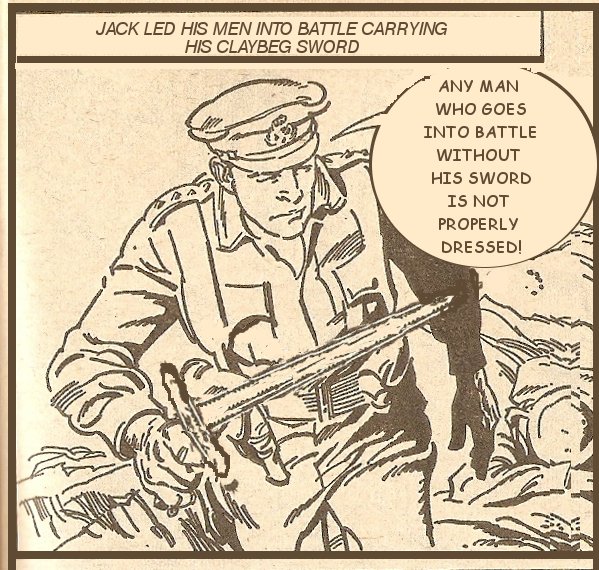
Any man who goes into battle without his sword is improperly dressed…
Before embarking, Churchill had Purle of London (one of the finest traditional bow and arrow makers of the late nineteenth and early twentieth centuries) make him an 85-pound bow of Spanish yew and a quantity of broadhead aluminum hunting arrows. The arrows were expensive, and the money came out of Churchill’s pocket, as it had been several hundred years since the War Office had taken responsibility for archery supplies. The weapon was silent, accurate to 200 yards and lethal in Churchill’s hands. As befitted his love of things Scottish he also acquired a Scottish broadsword, a traditional Claymore (technically a Caybeg, the true claymore being an enormous two-handed sword).which he would carry with him into battle in Finland and for the remainder of WW2.
When Wingate questioned him about the sword, he immediately replied “any officer who goes into action without his sword is improperly armed.” Wingate, who was somewhat of an aficionado of the use of cold steel himself, merely laughed. As CO of “B Company, Churchill began rigorously training his men from the moment he took command. On arrival in Finland, he took to the intensive and fast-paced Maavoimat training program like a duck to water, leading his men as they were trained in survival, land navigation, close quarter combat, silent killing, signaling, demolitions, tactical assaults and retreats and shooting, where they learned to use every type of weapon the Maavoimat had in use as well as some of those that they would be likely to encounter in Red Army hands.
OTL Note (Churchill actually volunteered and was accepted for the 5th Battalion, Scots Guards but I’ve moved him to Wingate’s battalion).
On first being posted to the rear lines on the Karelian Isthmus, Churchill volunteered to lead Platoons of the Atholl Highlanders on short stints at the front where the objective was to allow the men to gain combat experience against the Red Army on a “quiet” sector. Perhaps a little frustrated, “Captain Churchill decided on a symbolic gesture that he thought would not only give him great satisfaction but might also create a certain alarm, despondency, and bewilderment in the enemy lines. In his biographers words, “On April 15, while on patrol in no-man’s land, he stealthily made his way to about 50 to 80 yards from the Russian positions and fired three arrows in quick succession. Churchill was quoted as saying “There was a sudden commotion in the enemy’s position, and from the shouting and the confusion it sounded very much as if perhaps one of my broadheads had found a better mark than an inoffensive stag or bushbuck. Anyway, it is pleasant to think so.” The words of the Red Army commander on learning that one of his men had been spitted by a broad-head arrow have not been recorded but may be guessed at.
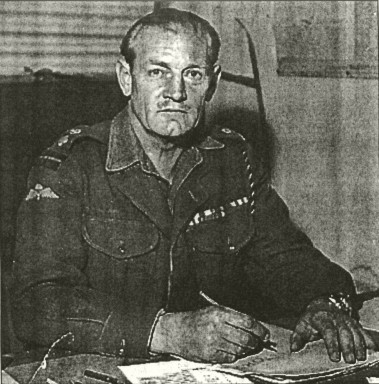
Major “Mad Jack” Churchill, CO “B” Company, Atholl Highlanders (Note the Maavoimat Parajaeger wings on the right shoulder of his uniform). Leading his unit into combat for the second time in Finland in Spring 1940, Churchill played “The March of the Cameron Men” on his bagpipes as his glider approached the landing site – near a Red Army Divisional Headquarters. He was determined to be the first man into action and was stowing his bagpipes when his glider touched down and two of his men pushed past him. He quickly leapt out and ran ahead, his sword in one hand and pistol in the other. The Company met disorganized resistance which was quickly overcome by the simple expedient of shooting every Red Army soldier in sight and overwhelming any attempt at serious resistance with instant attacks. In the course of the attack a hand grenade exploded and a fragment gashed Churchill’s forehead. The wound was painful and very obvious but not serious, and got him much sympathy when he visited Viipuri on a short leave after his Company returned to the rear to recover and regroup. Churchill later claimed that it began healing too quickly and had to be touched up with borrowed lipstick to keep the “wounded hero” story going for the remainder of his short leave.
Churchill was an aggressive leader and trainer, especially fond of raids and counterattacks, leading small groups of picked soldiers against the advancing Red Army and a firm believer in the Maavoimat’s axiom of extracting the maximum cost from the enemy as they attacked, whilst keeping the losses of one’s own men to a minimum. Three days after his first use of the longbow in action, he would lead another Section from one of his Company’s Platoons in an ambush of a Red Army patrol. He presented a strange, almost medieval figure at the head of his men, carrying not only his war bow and arrows, but his sword as well. After ensuring his men were in position to ambush the route the Red Army patrols were using, Churchill gave the signal to attack by silently cutting down the enemy Sergeant with a broadhead arrow, following which the ambush team took out the rest of the enemy patrol. The war-diary of the Maavoimat Regimental Combat Group, to which Churchill’s Company was temporarily attached whilst gaining experience, commented on this extraordinary figure. “One of the most strange sights of the war to date was the sight of Major Churchill of the British Volunteer Battalion passing through the lines with his men and carrying a bow and arrows and a sword. His spitting of Red Army soldiers with his bow and arrows … were a great source of amusement to the men.”
When Wingate volunteered the Atholl Highlanders to augment the Maavoimat ParaJaeger Division on the airborne landings that sowed confusion and chaos in the Red Army rear during the Spring Offensive on the Karelian Isthmus, Churchill leapt at the new challenge. The training period was short, and Churchill reveled in it. He was at home in the Finnish forests and swamps, in the snow and rain and the mud. He lived and breathed training, leading, driving, setting the example, praising excellence, and damning sloth and carelessness. His ad hoc lectures to his soldiers were couched in the plain language his men understood and liked, for instance: “There’s nothing worse than sitting on your bum doing nothing just because the enemy happens to leave you alone for a moment while he has a go at the unit on your flank. Pitch in and support your neighbor any way you can.…” There was also a bit of a downside to Jack Churchill. On those happy occasions when the Company was not in the field doing night training, he was sometimes given to awakening everybody in the Camp as he shattered the night with pipe music. No piper could possibly understand why some of the world would rather sleep than listen to martial piping however expert, and he was no exception. His comrades could only grit their teeth and hope that he would soon tire or think of something rather quieter to do. The training period ended in late April 1940, as the Maavoimat’s brilliantly successful assault down the length of the Karelian Isthmus began.
Churchill commanded “B” company in the attack, and Wingate had put “B” Company in the vanguard of the drop, believing that both Churchill and his Platoon Officers, Lt. Tatham-Warter, 2nd Lt David Vere Stead and 2nd Lt Patrick Dalzel-Job were all “thrusters”. Tasked with seizing two key road junctions and a critically important bridge, the Atholl Highlanders were to seize these at dawn on the first day of the offensive. “B” company would advance straight from the glider landing zone to the bridge while the rest of the battalion took the two road junctions. The initial landings were largely unopposed and the various Companies formed up quickly. Tatham-Warter set up the Battalion rendevous using smoke and lamps, before the order to move off came just after 6am. B Company was in action almost at once; ambushing a small Red Army recce group near the drop zone before moving off through the woods toward the river road, with each platoon taking turns to lead. Tatham-Warter led the vanguard one mile from the dropzone to the bridge at a cost of only one killed and a small number of men wounded whilst having killed something like 150 Russians.
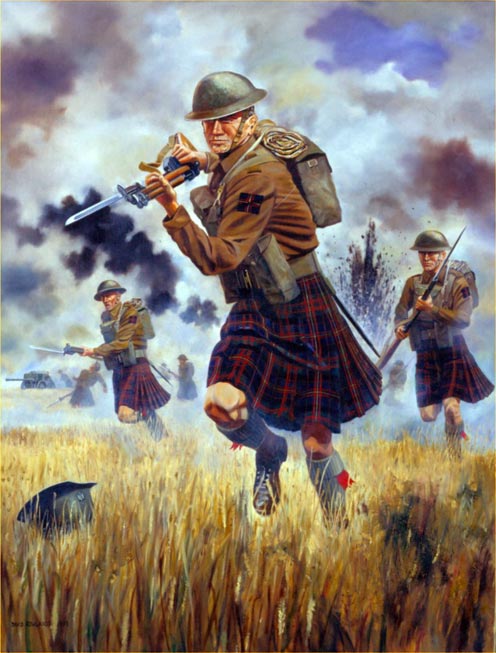
“B” Company were the only Company of the Atholl Highlanders to wear Kilts into action on the Karelian Isthmus in April 1940. Being unable to acquire genuine Atholl Highlanders kilts before their departure for Finland, Churchill had been given kilts by his old friends in the Cameron Highlanders. His men wore the service dress jacket, the kilt and khaki hose and puttees. No kilt aprons or sporrans were worn. The scene of the action in the painting is the fighting on the Isthmus near 1940. At the left can be seen a gun of the attached anti-tank section. In battle order, the small haversack was worn on the back. Above it was the anti-gas cape, held by two thin white tapes. The respirator was worn on the chest.
In the assault that took the Bridge, Churchill led the charge, his pipes screaming “The March of the Cameron Men.” Churchill and his men killed the Red Army soldiers guarding the bridge and, whilst still fighting off a heavy Red Army counter-attack, Churchill’s signal to Battalion Headquarters was terse: “Bridge captured. Casualties slight. Red Army counter-attacks in progress and being driven off. Churchill.”
Withdrawn two days later as the attacking 21st Pansaaridivisoona reached their positions, the Atholl Highlanders would re-equip and regroup over a two day period, following which they would make a further drop on the Isthmus, this time tasked with attacking and eliminating a Red Army Divisional Headquarters. Dropping into the midst of the Divisional Headquarters at 1am in the morning using a combination of the ParaJaegers highly secret JMW-110 Assault Glider-Gyrocopters (dropped in earlier to set out a landing area and landing lights for the main drop) and the JMW-100 and rather larger JMW-200 Gliders, the entire Battalion descended in silence on a drop zone within a mile of the targeted Divisional Headquarters. Their mission was to both eliminate the Divisional Headquarters and to capture or destroy nearby Red Army artillery batteries that could hold up the advance.
The 4am attack on the Divisional Headquarters met immediate and ferocious, if uncoordinated, resistance and the Battalion found itself fighting Red Army line infantry. Casualties were heavy, but the Atholl Highlanders beat down an uncordimated Red Army defence and moved rapidly to secure their objectives and destroy the Divisional Headquarters, working from detailed maps prepared from Ilmavoimat reconnaissance photos.For Churchill, the high point of the fighting was the attack made by his Company on the Red Army Artillery Regiment. He organized his men into three parallel Platoon-sized columns and, since the heavy undergrowth ruled out any chance of a silent advance, sent them charging through the darkness shouting the Finnish Army battle cry of “”Hakkaa päälle!” that the Atholl Highlanders had enthusiastically adopted. The yelling not only minimized the risk of the Atholl Highlanders shooting each other in the gloom, but also confused the Russian defenders, to whom this fierce shouting seemed to come from all directions in the blackness of the night. The attack carried all its objectives and resulted in the capture of 36 x 152mm Howitzers together with all their ammunition stockpiles and most of the transport in an undamaged condition. The men of the Red Army Artillery Regiment were slaughtered piecemeal, with fierce but ineffective resistance. In the morning light, the position was found to be carpeted with Red Army dead.
Churchill himself was far in front of his troopers. Sword in hand, accompanied by a corporal named Ruffell, he had advanced as far as a large Divisional Supply Depot. Undiscovered by the enemy, he and Ruffell heard Red Army soldiers digging in all around them in the gloom. The glow of a cigarette in the darkness told them the location of a Russian sentry post. What followed, even Churchill later admitted, was “a bit Errol Flynn-ish.” The first Russian sentry post, manned by two men, was taken in silence. Churchill, his sword blade gleaming in the night, appeared like a demon from the darkness, ordered “Pуки Bверх!” (Hands Up) and got immediate results.
He gave one Russian prisoner to Ruffell, then slipped his revolver lanyard around the second sentry’s neck and led him off to make the rounds of the other guards. Each post, lulled into a sense of security by the voice of their captive comrade, surrendered to this fearsome apparition with the ferocious mustache and the naked sword. Altogether, Churchill and Corporal Ruffell collected 42 prisoners, complete with their personal weapons. Churchill and his claymore then took the surrender of ten men in a bunch around the Supply Depot HQ. He and his NCO then marched the whole lot back to the Company HQ before detaching a Platoon to secure the Depot.
They were the only prisoners taken in the attack. He later had to dissuade Wingate from having them shot out of hand. “Wingate’s reason was we were behind enemy lines and couldn’t afford the men to guard prisoners. But as we were already being reinforced with a Finnish Battalion coming in on Gliders and we had Close Air Support on call and our own Artillery in range and we were expected the Finnish Army to arrive within the day I dissuaded him from this course of action. I’d always thought Wingate was rather a ruthless sort of chap and this convinced me completely. I wasn’t at all happy about the order, although of course if we had been in any danger I would have had them shot. As it was, after the War ended the Finns handed the Red Army prisoners back to the Russians and the NKVD of course had almost all of them shot, so in the long run there was no real difference for them.”
The Red Army would again launch a number of confused and uncoordinated counter-attacks throughout the next day, all of which were driven off. As the advance elements of the Maavoimat broke through to the Atholl Highlanders position, Churchill greeted the advancing Finns with another tune on the bagpipes, one of his favorites – “Will Ye No Come Back Again.” Long after the end of the war, Churchill was pleased to hear that the Finnish account of the fighting and the relief of the Atholl Highlanders described his lonely piping as “the doleful sound of an unknown British musical instrument.”
Will Ye No Come Back Again – “the doleful sound of an unknown British musical instrument.”
Churchill would later lead “B” Company in a series of deep-penetration raids behind the Red Army lines, in the course of which he continued to carry his trademark Scottish broadsword slung around his waist and a longbow and arrows around his neck and his bagpipes under his arm. The raids allowed him to give full vent to his martial inclinations and he delighted in the destruction of Red Army supply depots and rear area units as well as in ambushes of Red Army units. Perhaps the highlight for Churchill was the overrunning and destruction of a major artillery depot in the Red Army rear. “It was enormous, just thousands and thousands of artillery shells and hardly any guards. It was so far in the rear they obviously weren’t expecting us and we took them by surprise, killed all the guards and then spent a day setting all the demolition charges. We were miles away when they went off and it was the biggest explosion I’ve ever seen, literally mind-boggling. And then on the way back we were following a road which we shouldn’t have done and we ran into a truckload of Red Army soldiers coming towards us. We didn’t want any noise so after we stopped the trucks we piled in and bayoneted the lot of them. We’d just finished when another truck came round the corner and we realized it was the lead truck of what seemed to be a Battalion of Red Army troops. So we started to shoot them up, charging on foot down the side of the trucks killing as many as we could before they got organized. I sent B/3 Platoon to cut through the forest and take them in the rear and at the same time we got on the radio and called in Close Air Support from the Ilmavoimat. The Henley’s turned up inside half an hour and just blew them away, I don’t think there were any survivors. We had quite a party when we got back to our own lines.”
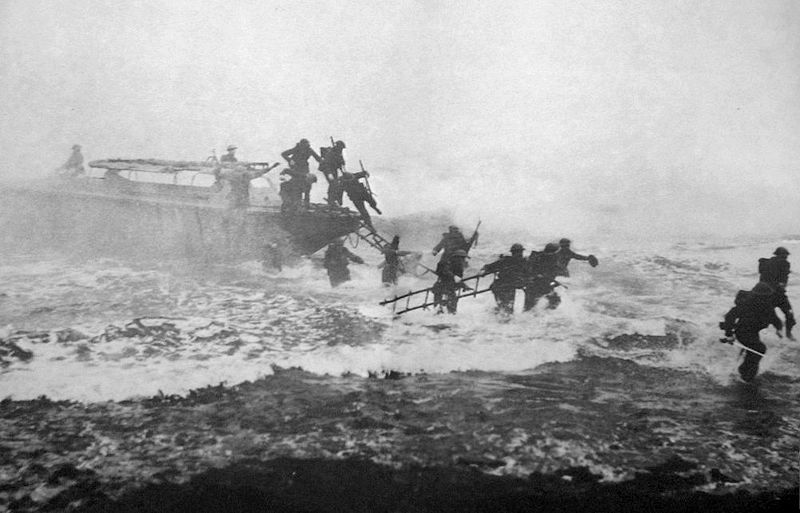
Jack Churchill (far right) leads men of “B” Company from a Finnish-built Higgins-designed Eureka boat on Lake Äänisen in an assault on Red Army positions, sword in hand.
Jack Churchill returned to Britain in late 1940 together with the remaining men of the Atholl Highlanders and promptly volunteered for the Commandoes. Training in Scotland with the Commandoes produced an unexpected dividend for Churchill. There he met Rosamund Denny, the daughter of a Scottish ship building baronet. They were married in Dumbarton in the spring of 1941, a happy marriage that would produce two children and last until Churchill’s death 55 years later. In 1941 he was second-in-command of a mixed force from 2 and 3 Commandos which raided Vågsøy, in Norway. The aim was to blow up local fish oil factories, sink shipping, gather intelligence, eliminate the garrison and bring home volunteers for the Free Norwegian Forces. Before landing, Churchill decided to look the part. He wore silver buttons he had acquired in France; carried his bow and arrows and once again armed himself with a broad-hilted claymore; and led the landing force ashore with his bagpipes. Although he was again wounded, the operation forced the Germans to concentrate large defensive forces in the area. For his actions at Vågsøy, Churchill received the Military Cross. After recovering, Churchill was appointed Lieutenant-Colonel commanding No 2 Commando which he took through Sicily (leading with his bagpipes into Messina) and then to the landings at Salerno in 1943.
In 1944, he led the Commandos in Yugoslavia, where they supported the efforts of Tito’s Partisans from the Adriatic island of Vis. A series of successful raids by Commandos and partisans hurt the Germans, and in May 1944, a more ambitious attack by British and Yugoslav personnel was planned on the German-held Yugoslav island of Brac. It was here that Jack Churchill’s luck at last ran out. The operation required attacks on three separate hilltop positions, dug in, mutually supporting, protected by wire and mines, and covered by artillery. Several Allied forces would have to work in cooperation. One of these, a reinforced Commando unit plus a large contingent of partisans, Jack Churchill would lead himself. While partisan attacks on the main German position got nowhere, 43 (Royal Marine) Commando went to the attack on the vital hill called Point 622. Pushing ahead in clear moonlight through wire and minefields, 43 Commando carried the hilltop but was forced to fall back with heavy casualties. Churchill now sent 40 Commando—also Royal Marines—in against the hill, and led them himself, playing the pipes. The leading troop went in yelling, shooting from the hip, and overran the German positions on 622.
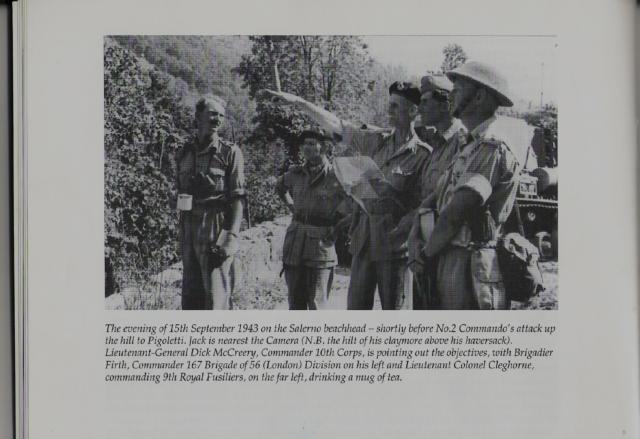
Jack Churchill at Salerno, 15th Sept. 1943: Jack is nearest the camera, the hilt of is claymore above his haversack.
But between casualties on the way up the hill and more casualties from very heavy German fire on the top, Churchill quickly found himself isolated with only a handful of defenders around him. There were only six Commandos on the hilltop, and three of those were wounded, two of them very badly. “I was distressed,” said Churchill with memorable understatement, “to find that everyone was armed with revolvers except myself, who had an American carbine.” Still, the little party fought on until the revolver ammunition was gone and Churchill was down to a single magazine for his carbine. A German mortar round killed three of his little party and wounded still another, leaving Churchill as the only unwounded defender on the hilltop. It was the end. Churchill turned to his pipes, playing “Will ye no come back again” until German grenades burst in his position and he was stunned by a fragment from one of them. He regained consciousness to discover German soldiers “prodding us, apparently to discover who was alive.”
Churchill would play his pipes one more time, at the funeral of the 14 Commandos who died on the slopes of Hill 622. He and his surviving men escaped killing by the Gestapo under Hitler’s “commando order” through the chivalry of one Captain Thuener of the Heer. “You are a soldier, as I am,” the captain told Churchill. “I refuse to allow these civilian butchers to deal with you. I shall say nothing of having received this order.” After the war, Churchill was able to personally thank Thuener for his decency and to help him stay out of the hands of the Yugoslav Communists. Churchill was flown to Sarajevo and then on to Berlin, there apparently being some thought that he was a relative of Winston Churchill. There is a story that on leaving the aircraft, he left behind a burning match or candle in a pile of paper, producing a fire and considerable confusion. During the inquiry that followed, Churchill innocently told a furious Luftwaffe officer that the army officer escorting Churchill had been smoking and reading the paper on board the aircraft. Churchill spent some time in solitary confinement, and in time he ended up in Sachsenhausen concentration camp. That infamous prison was only one more challenge to Churchill, however, and in September 1944, he and an RAF officer crawled under the wire through an abandoned drain and set out to walk to the Baltic coast. Their luck was not in, however, and they were recaptured near the coastal city of Rostock, only a few miles from the sea.
In time, they were moved to a camp at Niederdorf, Austria. Here, Churchill watched for another opportunity to escape, keeping a small rusty can and some onions hidden in his jacket in case a sudden opportunity should present itself. On an April night in 1945, it did. The chance came when the camp’s lighting system failed. Churchill seized the moment and walked away from a work detail, disappearing into the darkness and heading for the Alps and the Italian frontier. Liberating vegetables from Austrian gardens and cooking them in his tin can, he walked steadily south. Keeping off the roads, he crossed the Brenner Pass into Italy and headed for Verona, some 150 miles away. On the eighth day of his escape, hobbling along on a sprained ankle, Churchill caught sight of a column of armored vehicles. To his delight, their hulls carried the unmistakable white star of the United States Army. He managed to flag down one vehicle and persuade the crew that in spite of his scruffy appearance he was indeed a British colonel. As he later told his old friend and biographer, Rex King-Clark, “I couldn’t walk very well and was so out of breath I could scarcely talk, but I still managed a credible Sandhurst salute, which may have done the trick.”
Churchill was free but frustrated. The European war was almost over, and he had missed much of it, including the chance for further promotion and perhaps the opportunity to lead a Commando brigade. Nevertheless, hope sprang eternal. “However,” he said to friends, “there are still the Nips, aren’t there?” There were. And so Churchill went off to Burma, where the largest land war against Japan was still raging. Here, too, however, he met frustration, for by the time he reached India, Hiroshima and Nagasaki had disappeared in mushroom clouds, and the war abruptly ended. For a warrior like Churchill, the end of the fighting was bittersweet. “You know,” he said to a friend only half joking, “if it hadn’t been for those damned Yanks we could have kept the war going for another 10 years.” The abrupt departure of Japan from the war was a distinct disappointment to Churchill, especially since he had risen to the command of No 3 Commando Brigade in the Far East. Still, there were other brushfire wars still smoldering, and in November 1945, he reported home from Hong Kong, “As the Nips have double-crossed me by packing up, I’m about to join the team vs the Indonesians,” who were by then casting covetous eyes on Sarawak, Borneo, and Brunei. British and Commonwealth troops killed or expelled the invaders, but Jack missed this little war as well.
By the next year, he had transferred to the Seaforth Highlanders and then completed jump school, where, at 40, he qualified as a paratrooper. He made his first jump on his 40th birthday, and afterwards commanded the 5th (Scottish) Parachute Battalion, thus becoming the only officer to command both a Commando and a Parachute battalionHe took a little time off in 1946, this time for the movies. Twentieth Century Fox was making Ivanhoe with Churchill’s old rowing companion Robert Taylor and wanted him to appear as an archer, firing from the wall of Warwick Castle. Churchill took the assignment, flown off to the job in an aircraft provided by the movie company. In 1948 he ended up in Palestine as second-in-command of 1st Battalion, the Highland Light Infantry. Back in Britain, he was for two years second-in-command of the Army Apprentices School at Chepstow before serving a two-year stint as Chief Instructor, Land/Air Warfare School in Australia, where he became a passionate devotee of the surfboard.
Back in England, Churchill joined the War Office Selection Board at Barton Stacey and during this period he was the first man to ride the River Severn’s five-foot tidal bore and designed his own board. His last post was as First Commandant of the Outward Bound School. In retirement, however, his eccentricity continued. He finally retired from the army in 1959 but went right on working as a Ministry of Defense civilian overseeing the training of Cadet Force youngsters in the London District. One of his old friends wrote later that Churchill liked the job not only because of his association with the enthusiastic cadets, but also because the job gave him an office in Horse Guards at Whitehall, and a window from which he could watch troopers of the Household Cavalry mounting guard in a courtyard below him.In his last job he would often startle train conductors and passengers by standing up, opening the train window and throwing his attaché case out of the train window, then calmly resume his seat. He later explained that he was tossing his case into his own back garden so he wouldn’t have to carry it from the station.
He also devoted himself to his hobby of buying and refurbishing coal-fired steam launches on the Thames; he acquired 11, making journeys from Richmond to Oxford with Churchill decked out in an impeccable yachting cap and Rosamund giving appropriate sailing orders to her husband. He was also a keen maker of radio-controlled model boats, mostly warships, which he sold at a profit and which are now sought-after collectors’ items. He also took part in motor-cycling speed trials. Churchill passed away peacefully at his home in Surrey in the spring of 1996, but he left a legacy of daring that survives to this day.
His biography, “Jack Churchill: Unlimited Boldness” by Lieutenant-Colonel Rex King-Clark is not so easily available second-hand but if you can get it, its well worth a read, even though its fairly short at only 28 pages.
As it turned out, “Mad Jack” Churchill did leave something of a legacy in Finland. The Atholl Highlanders had worked closely on the Karelian Isthmus with the 21st Pansaaridivisoona and at some stage the tankers had acquired somewhat of a liking for the bagpipes, eventually forming their own Pipe Band. In the video below, we can see the Division’s Pipe Band leading a Maavoimat parade through one of the few areas of Königsberg (in East Prussia) still standing after the RAF bomber raids of 1944. This parade was shortly after the city fell to the Maavoimat. (Although Hitler had declared Königsberg an “invincible bastion of German spirit”, the German military commander of Königsberg, General Otto Lasch, had surrendered the city and the foreces under his command without a fight. For this act, Lasch was condemned to death in absentia by Hitler). Post capture by the Maavoimat, Königsberg would become a haven for German refugees in East Prussia and Poland and the location of a major Maavoimat POW and internment camp for captured members of the German military. Königsberg would also be a major bone of contention in the post-war negotiations as the ruling Soviet triumvirate wanted a year-round ice-free harbor.
Elements of the 21st Pansaaridivisoona parading through Königsberg in early 1945, led by the Maavoimat’s one and only Divisional Pipe Band. Sadly, in the post-war years, this Military Pipe Band has disappeared and the only traces now of the Bagpipes in Finland are a small number of civilian pipe bands.
Post-War Note: At the end of World War II in 1945, the Soviet Union demanded the annexation of the city of Königsberg and the surrounding areas of East Prussia as as part of the Russian SFSR, pending the final determination of territorial questions at the peace settlement as agreed upon by the Allies at Yalta. At the Potsdam Conference, the Conference examined a proposal by the Soviet Government regarding Königsberg and East Prussia. The President of the United States and the British Prime Minister declared that they would support the proposal of the Conference at the forthcoming peace settlement and stated that they agreed in principle to the proposal of the Soviet Government concerning the ultimate transfer to the Soviet Union of the city of Koenigsberg and the area adjacent to it as described above, subject to expert examination of the actual frontier.
The Finnish and Polish Governments stated in their turn that East Prussia was in the Finnish Zone of Control and no such agreement would be recognised by Finland or Poland, just as no movement of the eastern Polish border would be countenanced and just as the Soviet claims to the Baltic States as a result of the agreements signed under duress in 1940 were not recognised. Inevitably this led to a long period of tension in the immediate aftermath of WW2 and into the years of the Cold War. As a result of the Finnish refusal to back down to the Soviet Union, and the terrifying reputation of the Finnish military at the time (including their willingness to take on Red Army combat formations many times their size and annihilate them, as had occurred a number of times in the last few months of the war), the post-war delineation of Baltic borders resulted in the independent state of Baltic Prussia being formed and recognised, with its capital being Königsberg. A magnet for German refugees from the rest of Eastern Europe and from Poland, Baltic Prussia became a hub for the rapid post-war recovery of the Baltic States and today is a small but prosperous state closely aligned with Poland, Lithuania, Latvia, Estonia and Finland.
OTL Note: Many people fled Königsberg ahead of the Red Army’s advance after October 1944, particularly after word spread of the Soviet atrocities at Nemmersdorf. In early 1945 Soviet forces under the command of the Polish-born Soviet Marshall Konstantin Rokossovskiy besieged the city. In Operation Samland, General Baghramyan’s 1st Baltic Front, now known as the Samland Group, captured Königsberg in April. [On April 9 — one month before the end of the war in Europe — the German military commander of Königsberg, General Otto Lasch, surrendered the remnants of his forces following a three-month-long siege by the Red Army. For this act, Lasch was condemned to death in absentia by Hitler. At the time of the surrender, military and civilian dead in the city were estimated at 42,000, with the Red Army claiming over 90,000 prisoners. About 120,000 survivors remained in the ruins of the devastated city. These survivors, mainly women, children and the elderly and a few others who returned immediately after the fighting ended, were held as virtual prisoners until 1949. A majority of the German citizens remaining in Königsberg after 1945 died of either disease, starvation or revenge driven ethnic cleansing. The German population was either deported to the Western Zones of occupied Germany or into Siberian labor camps, where about half of them perished of hunger or diseases The remaining 20,000 German residents were expelled in 1949–50. Resettled by Russians, Russian Kaliningrad and the surround area is now a blighted and impoverished region with very few redeeming features.
The Atholl Highlanders
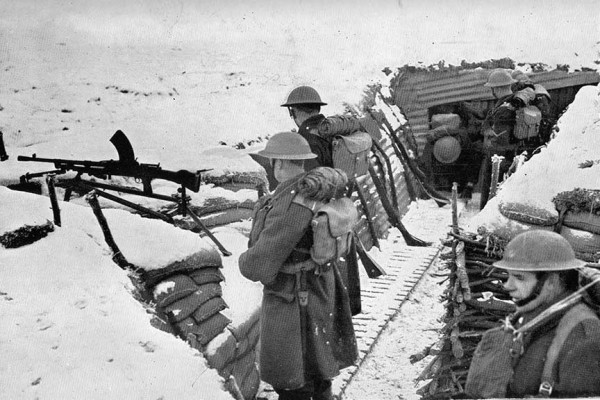
Men of the Atholl Highlanders on the Karelian Isthmus – Rear Lines – February 1940
By Maavoimat standards, the Atholl Highlanders were not well-trained or well-equipped for winter warfare under Finnish conditions and as a result, they would initially man rear line fallback positions along the Mannerheim Line during the heavy fighting of February 1940. In Spring, both the British Volunteer battalions, the Atholl Highlanders and the later arriving 5th Battalion (Special Reserve), Scots Guards, would take part in the Karelian Isthmus offensive and see heavy fighting in mopping up bypassed Red Army units. They would later fight in Eastern Karelia.
Once Maavoimat training had been completed, the men of both Battalions proved to be excellent soldiers, well led, courageous and aggressive. Many of the officers and men from both Battalions would go on to serve in British Special Forces formations (perhaps most notably, Orde Wingate, commander of the Atholl Highlanders who would go on to found the Chindits and David Stirling from the 5th Battalion Scots Guards, who would go on to found the Special Air Service – the SAS – but there were many many others).
After the end of the Winter War and the repatriation of it’s men back to Britain, the Atholl Highlanders would once more fade back into obscurity. However, for a brief few months, the unit formed the incubator for many of the men who would go on to become founding members and leading lights in many of the British Army’s special forces units of the Second World War. As history has moved on, the role played by the Atholl Highlanders and the 5th Battalion Scots Guards has largely been forgotten, as has the role of that first Finnish Special Forces unit, Osasto Nyrki, in training and fighting with the men of these two Battalions.
Return to Table of Content
Previous Page: The Atholl Highlanders
Next Page:
 Copyright secured by Digiprove © 2015 Alternative Finland
Copyright secured by Digiprove © 2015 Alternative Finland


